Last Updated: February 19th, 2024
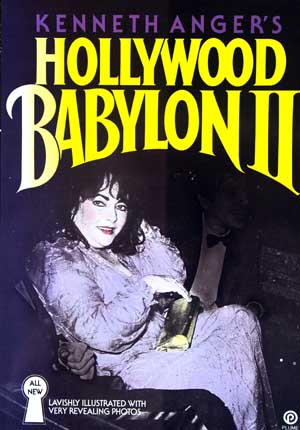 |
1. ANGER, KENNETH: "Kenneth Anger's Hollywood Babylon II" (Plume) (Soft Cover and Book: Near Mint Condition. Lavishly illustrated with revealing pictures. 332 pages. Originally published in Paris, this is a collection of Hollywood's darkest and best kept secrets from the pen of Kenneth Anger, a former child movie actor who grew up to become one of America's leading underground film-makers. Classic read. price: 25 Euro |
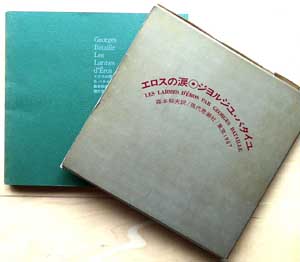 |
2. BATAILLE,
GEORGE: “Les Larmes D’Eros –
Erosu No Namida” (Gendai Shichosha – 1971 – 280 pages) (Slip Case
Cover: Excellent/ Dust Jacket: Excellent/ Book and pages: Near Mint). Rare
Japan 1971 first printing of cornerstone work. Fully illustrated. Tears of Eros is the
culmination of Georges Bataille's inquiries into the relationship between
violence and the sacred. Taking up such figures as Giles de Rais, Erzebet
Bathory, the Marquis de Sade, El Greco, Gustave Moreau, Andre Breton, Voodoo
practitioners, and Chinese torture victims, Bataille reveals their common
obsession: death. This essay, illustrated with artwork from every era, was
developed out of ideas explored in Erotism: Death and Sexuality and Prehistoric Painting: Lascaux or the Birth
of Art. In it Bataille examines
death—the "little death" that follows sexual climax, the
proximate death in sadomasochistic practices, and death as part of religious
ritual and sacrifice. Price: 75 Euro |
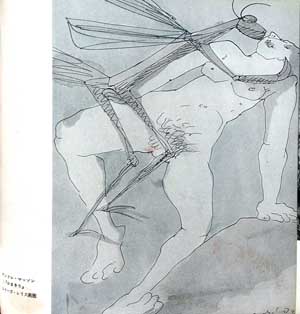 |
|
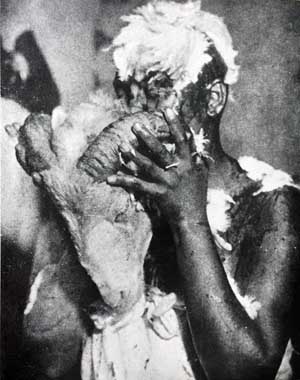 |
|
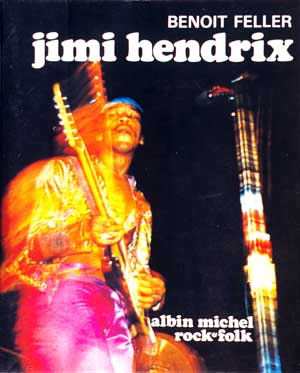 |
3. BENOIT FELLER/ ALBIN MICHEL: “Jimi
Hendrix” (Rock & Folk – Paris – 1976) (Near Mint Condition).
Original French 1976 first printing. 192 pages, fully illustrated. Stocked with
rare vintage Hendrix Pics. Rarely surfaces. Price: 75 Euro |
 |
4. BLACK MONK TIME: “S/T” (Mint Condition) Researched and written bu Thomas Edward Shaw. Published by Carson Street Publishers, this is the VERY FIRST printed edition of October 1944. This is still a landmark of sorts as a must-have account of being in a band that none of the members dreamed would become a worldwide cult at the time. Well worth reading, not just for the stranger-than-fiction story of the MONKS but also for the witty way in which it's told, with a fine eye for the theatre of the absurd that seemed to take control of their destiny even they were called that. "My hate is everlasting baby" was something the world wouldn't be able to deal with for 30 years. The Monks out-sexed the Pistols 10 years before punks had their day. The darl twisted sounds of the Monks produced by five outcast service man in a 1960s Germany has a hell of a lot more in common with a cyberpunk, cynical 90s world view than it does with the pap usually associated with the acid drenched free love bullshit naivete that one identifies with the Woodstock Generation. KILLER account. Price: 70 Euro |
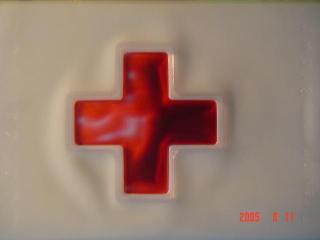 |
5. BROWN, TREVOR “Medical Fun” (Pan-Exotica)Insanely collectible book by enfant terrible Trevor Brown. Signed copy by the man himself. Numbered edition of only 500 copies and this one is copy 007/500. Totally mint condition. Comes with outside plastic bag, cover is in plastic and the cross adorning the cover is filled with a red liquid resembling blood. Cover and cross are as new as can be. First edition stuffed with bizarre and criminally sick-erotic drawings. Highly recommended. SIGNED NUMBERED COPY!!!!! Price: 120 Euro |
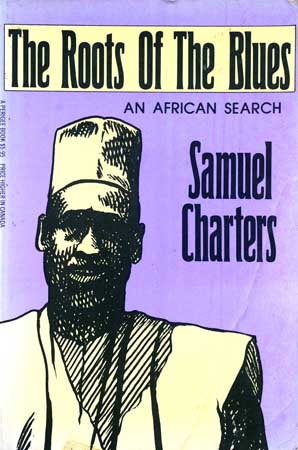 |
6. CHARTERS, SAMUEL: "The Roots Of The Blues - An African Saerch" (Perigree - Jazz Studies). (Soft cover and Book in excellent condition). First printing of 1982. Fully illustrated and 151 pages. I went to Africa to find the roots of the blues. So Samuel Charters begins the extraordinary story of his research. But what began as a study of how the blues was handed down from African slaves to musicians of today via the slave ships, became something much more complex. For in Africa Samuel Charters discovered a music which was not just a part of the past but a very vital living part of African culture. The Roots of the Blues not only reveals Charters's remarkable talent in discussing African folk music and its relationship with American blues; it demonstrates his power as a descriptive and narrative writer. Using extensive quotations of song lyrics and some remarkable photographs of the musicians, Charters has created a unique contribution to our understanding of both African and American cultures and their music. 1982 rare first print. Price: 40 Euro |
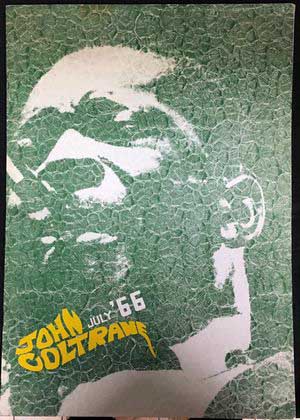 |
7. COLTRANE, JOHN - "JULY 1966" (Excellent Condition) Bloody rare and hopelessly hard to get ORIGINAL 1966 mini poster/ pamphlet to announce Coltranes legendary 1966 Japan tour. Size is 26cm - 36cm. 36 fully illustrated pages with full line up introduction and beautiful color and B&W pictures. This was only on sale during Coltrane's 1966 concerts. Fantastic condition and so hard to dig up. Beautifully designed and needless to say very rare and of historical importance. Price: 250 Euro |
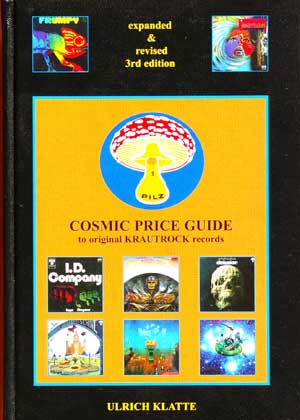 |
8. COSMIC PRICE GUIDE: “S/T”
(Mint Condition) Hard Cover edition. Compiled and written by Ulrich Klatte, this is the 3rd and final expanded and revised edition. 450 paged worth of detailed info - complete with full color reproductions of all the sleeves - of all the German Krautrock and jazz records ever recorded. Comes with release info, catalogue numbers, different issues, etc. A wealth of information and all you needed to know on Cosmic German sounds. Price: 50 Euro |
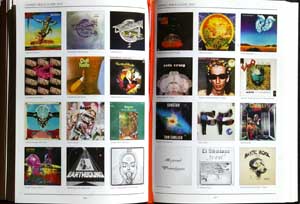 |
|
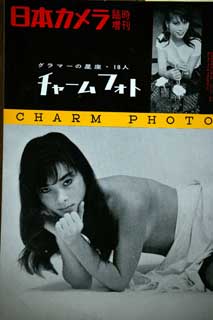 |
9. CHARM PHOTO: “S/T” (Ni Hon Kamera Sha) (Mint Condition). Original November 20th, 1957 issue. Semi-erotic nude photo magazine out of 1957, focusing on that day up and coming still undetected actresses and chanteuses. What makes this issue so collectible and highly sought-after is that it has the largest bulk of its pages devoted to the – then – still unknown 18 year old Hamamura Michiko, the late 1950s mambo chic par excellence. Even before she hit it big time, becoming one of Japan’s biggest post war singers, she already had that beauty that renders you senseless. Michiko’s intoxicating spell of South American calypso rhythms freely mutate during this photo shoot with oriental mood swings. So enough mondo exotic femininity for you? Dynamite stuff if you are interested in the aesthetic of late 1950s erotic Japanese actresses and chanteuses. Massive and impossible to dig up. Top vintage condition. Price: 150 Euro |
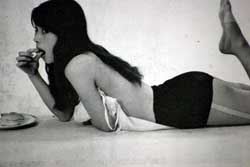 |
|
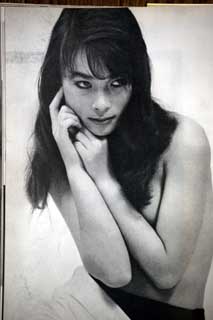 |
|
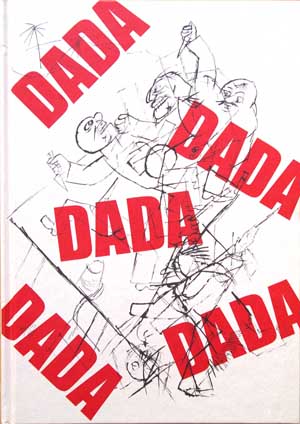 |
10. DADA - Edition Gallery Ronny Van De Velde - Promotion only edition and extremely limited. (Hard Cover Book is in Near Mint Condition). 288 pages, thick high quality printed paper and heavy. Amazing collection and fully illustrated work focussing on all the major participants of the Dada movement, including works by Tristan Tzara, Carlo Carra; Paul Citroen; Arthur Cravan; Jean Crotti; Otto Dix; Marcel Duchamps; Jean-Jacques Gailliard; Albert Gleizes; George Grosz; Raoul Hausmann; Erich Heckel; Richard Huelsenbeck; Paul Joostens; Rene Magritte and many others. Eyepopping great reproductions and a massive work on Dada. Never offered before... and rare to say the least. One time only limited edition printing housed in thicker than life hard cover. Price: 300 Euro |
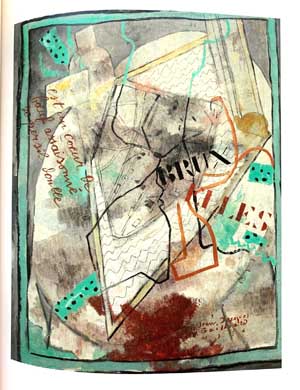 |
|
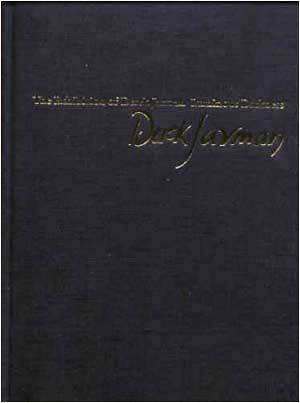 |
11. DEREK JARMAN: “The Exhibition of Derek Jarman Luminous Darkness” (Uplink) (Book: Mint/ Binding: Mint/ Cover: Mint). Rare Japan only release of 1990, following a Jarman exhibition in Tokyo. Small printing, all is in top condition. Heavy quality imprinted paper, cloth and textured jacket. Price: 150 Euro |
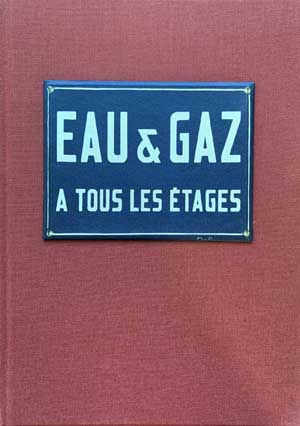 |
12. DUCHAMPS, MARCEL: "Eau & Gaz - A Tous Les Etages" Edition Gallery Ronny Van De Velde - Promotion only edition and extremely limited. (Hard Cover Book is in Near Mint Condition). Cloth covered hard covere with metal plate on front of the cover. 175 pages, and comes with a variety of inserts and letters, thick high quality printed paper and heavy. Amazing collection and fully illustrated work focussing on Marcel Duchamps and other leading surrealists of that era. Eyepopping great reproductions and a massive work on Duchamps. Never offered before... and rare to say the least. One time only limited edition printing housed in thicker than life hard cover. Price: 350 Euro |
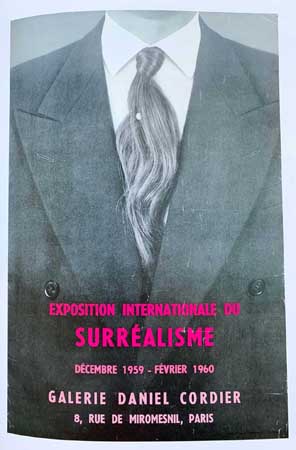 |
|
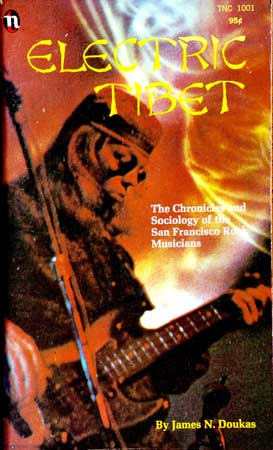 |
13. ELECTRIC TIBET by James N. Doukas. In 1969, San Francisco's eminent jazz critic Ralph J. Gleason's book on San Francisco rock appeared, perhaps the best book written on the scene in the Sixties. A little known book was rushed into print before Gleason's book came out, doubtless to capitalize on Gleason's advance press. The rival turned out to be one of the least known and most interesting books written on the early years of the San Francisco sound, with the wonderful title Electric Tibet. “The rarest S F rock history book that I know of is also the earliest, published in April 1969. While an essential tome for hardcore SF heads I'm afraid it's not terribly impressive. The book (published by an obscure house with minimal proof-reading and some cheap errors) was a college project and feels like it. In order to please his professor Doukas had to insert Sociology aspects into his rambling interviews with various ballroom freaks, so you often get unexpected "scientific" statements like "San Francisco is unique, because the musicians meet a lot of people".
Highpoints include a rare interview with the Ace Of Cups (not all that extensive), Nick Gravenites (who is obviously a smart, analytic guy), and a long chat with Chicken Hirsh who turns out to be quite a philosopher. A bunch of other acid rock luminaries talk too, but these interviews are invariably disappointing and add no new data. There's a whole chapter on the Airplane who wouldn't give Doukas the time of day, yet he printed what he had. The book is not hopeless by any means, but would have been much better without the under-graduate academic angle. Some proof-reading and research might have spared us references to the "Sons Of Chaplin" or "Mountain Grow" (=Mountain Girl).” (Lama Reviews) If Tibet had been published by a major house, it would have become one of the indispensable titles in every San Francisco rock fan's library; that is, after all, a slender library. As it is, Tibet turns up only on the shelves of the fortunate and the serious collectors. Dominion was a pornographic book publisher, whose bread-and-butter was the cheap paperback with lurid covers and graphic, suggestive titles. But like many porno publishers in the Sixties, they put out non-porn titles that they in some way believed in, or perhaps hoped would lend a little mainstream respectability. As a result, the book has been very poorly distributed. Copies now fetch ridiculously high prices depending on condition. The classic, psychedelic cover distorts this even more: many paperback collectors, who want only pristine copies with garish covers, lap this one up. Written in mid-1968, with updates to cover what had happened prior to publishing. No images. Nice front cover shot of Jack Cassady though. 190 pp. NEAR MINT condition, 1st press issue. Price: 250 Euro |
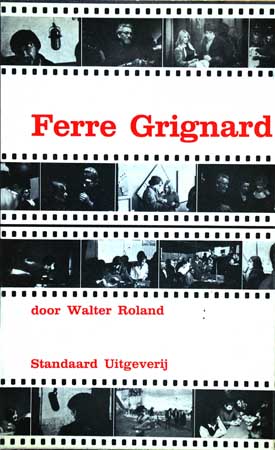 |
14. FERRE GRIGNARD door Walter Roland. (Standaard Uitgeverij). Bloody rare 1967 first and only edition, published and printed in Antwerp, Belgium, the home town of enfant terrible folk& blues singer Ferre Grignard. 93 fully illustrated pages. Counter cultural rare document. Price: 150 Euro |
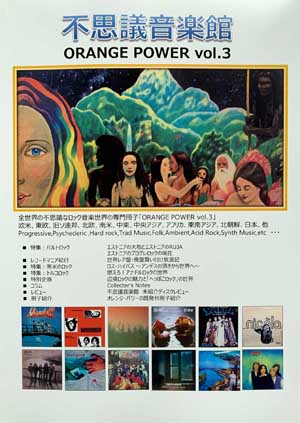 |
15. FUSHIGI ONGAKU KAN: “Orange Power Vol. 3” (Orange Power). Third volume of extremely limited privately issued magazine 112 pages thick and focusing on weird and strange private press issues that are even too obscure to get a mention in any of the Pokora books. Filled with reviews and jacket sleeve art and ranging from every possible shithole country on the globe that gave birth to some obscure progressive rock or psychedelic headspin record, this little gem of a book covers all of that ground. If totally obscure and rare records are your thang, well is the next level entry guide book for your digging adventures. Limited print of a few hundred, sold out on the day it hit the shelves but a treasure throve of info. Price: 50 Euro |
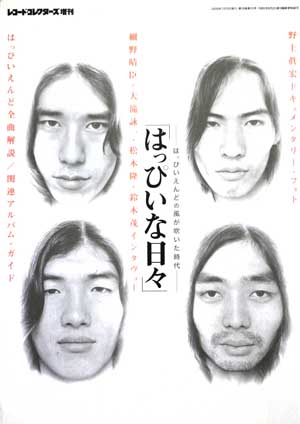 |
16. The HAPPY END: “Happy Na Hinichi – Happy End No Kaze Ga Fuita Jidai” (Record Collectors – July 2000) (Mint Condition). 160 pages. Fully illustrated with archival photographs. Comes with fully annotated discography of Happy End and its offspring. This was a limited anniversary release that was put out in July 2000. If you have any interest in Japanese psychedelic rock, this book is fantastic. The archival photos are plentiful and beautiful and shed a clear light on the band during its embryonic days up until their last incarnation. Interviews with all the members and affiliates, detailed illustrated essays on their musical influences and much more. Top condition. Price: 50 Euro |
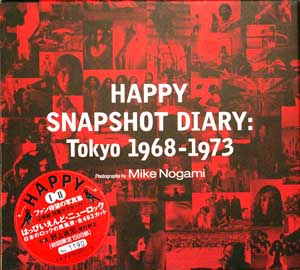 |
17. The HAPPY END – Photographs By Mike Nogami: “Happy Snapshot Diary: Tokyo 1968 – 1973” (Blues Interaction). (Two hard cover books with dust jackets: Mint/ Poster: Mint/ hardcover Slipcase that housed both books: Mint) 2002 limited release of only 1500 copies all numbered. This copy is number 1190. It houses 2 hard cover 200 paged photo books and one poster all housed in a hard box slip case. Both books are graced with dust jackets. Book One focuses on the years 1968 – 1970 and the majority of the beautiful art like pictures and snapshots is focused on the APRYL FOOL, the band predating the Happy End. Stuffed with never seen before archival pictures of the band in action, during recording and live sessions and interacting with scenesters. Book two focuses on the years 1970 – 1973 the hey-days of the Happy End. Again stuffed to bursting with archival footage, beautifully done, a sight for soar eyes. Went immediately out of print on the day it was released, mainly on subscription only, finally I have the chance to offer a totally MINT copy of this historical artifact. One of the most eye-popping documents to give photographic insight into Tokyo’s psychedelic music scene of the period 1968 to 1973. Price: 150 Euro |
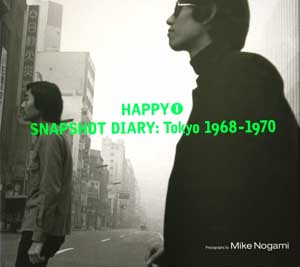 |
|
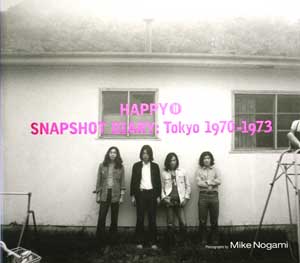 |
|
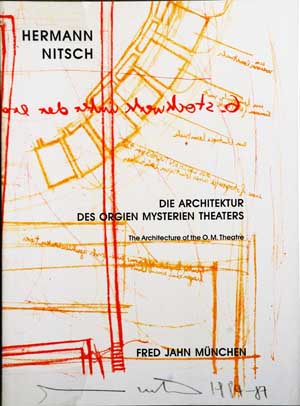 |
18. HERMANN NITSCH: “Die Architektur Des Orgien Mysterien Theaters – The Architecture of the O. M. Theatre – VOL. 1” (Verlag Fred Jahn – 1987) (Cover and paged are MINT). First and sole edition. Volume one of two. Beautiful gallery edition book shedding a light on Nitsch’s insanely beautiful and eye-popping etchings, lithographs and pen drawings, studies in his Orgien Mysterien Theatre to unfold on later. 128 pages, high quality paper, spine and all intact. TOP copy! Price: 150 Euro |
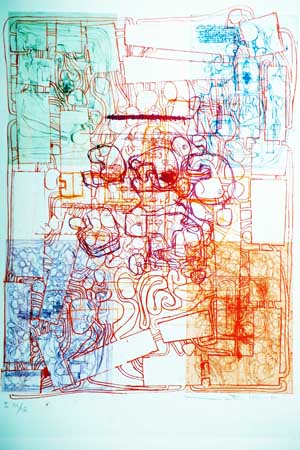 |
|
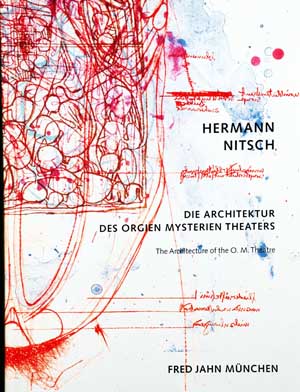 |
19. HERMANN NITSCH: “Die Architektur Des Orgien Mysterien Theaters – The Architecture of the O. M. Theatre – VOL. 2” (Verlag Fred Jahn – 1993) (Cover and paged are MINT). First and sole edition. Volume two of two. Beautiful gallery edition book shedding a light on Nitsch’s insanely beautiful and eye-popping etchings, lithographs and pen drawings, studies in his Orgien Mysterien Theatre to unfold on later. 175 pages, high quality paper, spine and all intact. TOP copy! Price: 150 Euro |
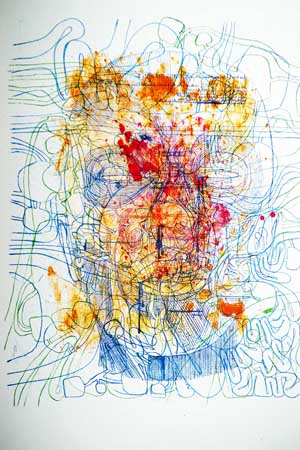 |
|
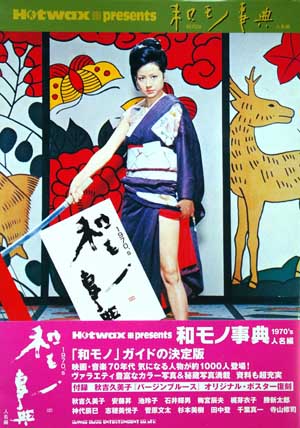 |
20. HOTWAX PRESENTS: “WAMONO JITEN” (Shinko Music – 2006) (Dust Jacket: Mint/ Book: Mint/
Poster: Mint). Top condition of rare and long evaporated book. 207 paged crammed
to bursting with vintage underground movie and sleazy music activity. From Kaji Meiko to Ike Reiko and back again, Nikkatsu Roman
Porno flicks over to Toho New Action Cinema, from white screen gangsters, pimps
and hustlers to sleazy sexy vixens with a secret agenda, this is a treasure
throve of 1970s underground Japanese sleaze and violence, adulterated musical
fringe activities and sword wielding girls, from the Flower Travellin’
Band and Koji Wakamatsu’s underground sex and violence flicks to Arai Yumi and Carmen Maki to ooze the pain. From Zunokeisatsu
and PYG over to Japan’s answer of Gainsbourg – Tsutsumi Kyohei, this
eye-popping book gives in great detail a colorful and vivid overview into
Japan’s 1970s shadowy world of music, sex, violence, underground movies and
other tantalizing pleasures. Awesome collection and study into Japan’s 1970s
fringe cultural activities. Top copy!!!! Price: 150
Euro |
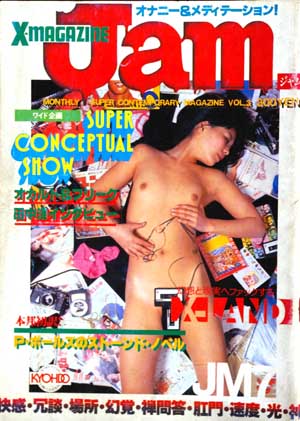 |
21. JAM – X-MAGAZINE: “Super Conceptual Show
– Vol. 3 – JM7” (Jam Shuppan – 1980) (Near Mint). Another
mental brain fuck in the good sense of the word, but a brain fuck
nevertheless….. Ever been skull-fucked before? No? Well JAM comes to the rescue
with this issue!!! It is the same award winning recipe of “Sexual Meditation”,
“Visual Highs”, “Tokyo New Wave”, “Mushroom Growing Magic”, “A Stoned Novella”,
“Freaks – Myths & Images of the Secret Self” (Dog Faced Boy,
Pinheads, Phaliform Clitoris/ plain oddities), “SM – SF Short Story” (by
Yamazaki Haruo of Gasaneta), Just plain weird shit that is utterly cool (Hells
Angels, Bondage, Nudity, Bongs, Drugs), Fabulous Furry Freak Brothers, TAO,
Disc reviews like Tangerine Dream’s Electronic Meditation, Electronic Music
weirdness, Suicide and Alan Vega, Weird Scum sex comics devoid of all possible
talent, nude porn panty pictures, masturbating and whipped cream pussy covered
action, etc. Man this magazine was beyond GREAT!!! Truly underground cum art
and mind-expanding weirdness that came out of a restricted society Japan was
(and still is) till this day. It broke rules and every possible taboo and it
ROCKED!!!! Copies are utterly scarce and next to impossible to find. This is
the pinnacle of underground high art and low culture. Stunning!!!! Never read
or saw anything that rocked my boat like JAM and HEAVEN, this is IT!!! Price:
300 Euro |
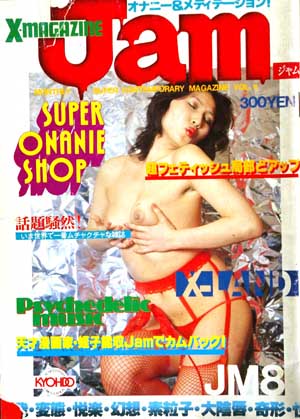 |
22. JAM – X-MAGAZINE: “Super Onanie Shop
– Vol. 4 – JM8” (Jam Shuppan – 1980) (Excellent). So with a
heading like this one – how can you possibly derail back into normal life
again? I have been there but never want to go back again and partly this is
thanks to being fucked up by JAM in my early twenties when I discovered this
issue. For starters the cover was great, red garter belt Japanese lady
massaging her tits with under her a heading for “Psychedelic Music”. WOW!!!! I
sure came to the right place. Upon opening up You will get treated to garter
belt masturbating ladies and dildo shoving beauties before emerging into the
bizarre cultural underground of puppet nymphs, Magazine Freak-Up rundown, Takasugi
Zen’s Bad Trip, strange adolescent nudity, Astro Boy cut ups, Sumo wrestling
antics, disfeatured comic art, LAFMS overview(!!!!) with Chrome, Wild Man
Fischer, Fred Blassie, 13th Floor Elevators, Half-Japanese,
Tuxedomoon, Doo-dooettes, Tom Wolfe Interview, Lewis Furry expose, strange
comic extravaganza, candle- scuffing ass antics, etc…. JAM had it all. It will
blow your mind, even after 45 years... It sure blew the minds of the straights
as it will do this day also (while being reigned by the lowest cultural
dominator ever – at a time when we cannot sink any lower, Jam gets so
much more relevant again)… high and low culture joining forces…without ever
degrading to a mindless pulp. This shit was revolutionary and it still is. Best
magazine ever worldwide! Price: 300 Euro |
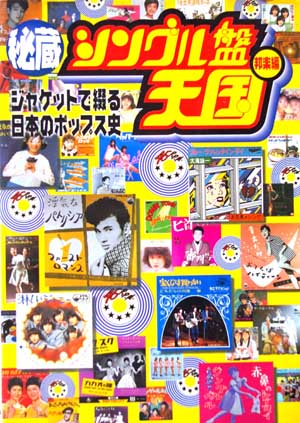 |
23. JAPANESE SINGLE EDITIONS FOR JAPANESE ARTISTS/ SHINGURU BAN TENGOKU: “S/T” (Shinko Music) (Dust Jacket, Spine, Book and Pages are in Near Mint Condition). Rare and long out of print version of this 1996 book. Over more than 130 pages, you will get hit senseless with single jackets and their alternate design as they came out here in Japan between 1950 and 1985 for a wide range of Japanese pop, rock and kayokyoku artists. Ranging from blues, surf trash, psychedelic, kayokyoku pops, enka drifters, folk, traditional, etc, this is a treasure throve of information. Alternating between black and white and full color reproduction pages, there are about 16 and 20 singles listed a page, complete with label info, release date, track listing, etc, so do the math and you get an idea of about how many singles are listed in this book. Many reproductions of rarely seen singles by a whole string of obscure and well known artists. Fabulous book that will help you to crack open and penetrate the Japanese singles market and zoom in on those rarely offered masterpieces. Essential for any record buff and aspiring collector. Long out of print and seldom seen these days. Price: 100 Euro |
 |
24. JAPANESE SINGLE EDITIONS FOR WESTRN ARTISTS between 1950 ~ 1980/ SHINGURU RECORDS TAIZEN: “S/T” (FUSOSHA) (Dust Jacket, Spine, Obi, Book and Pages are in Near Mint Condition). Rare and long out of print version of this 1999 book. Over more than 330 pages, you will get hit senseless with single jackets and their alternate design as they came out here in Japan between 1950 and 1980 for a wide range of European and US artists. Ranging from blues, surf trash, psychedelic, swamp rock, southern rock, Beatles, pub rock, folk, traditional, etc., this is a treasure throve of information. Alternating between black and white and full color reproduction pages, there are about 25 singles listed a page, complete with label info, release date, track listing, etc., so do the math and you get an idea of about how many singles are listed in this book – around 4760 items listed in technicolor splendor. Many reproductions of rarely seen singles by Blue Cheer, Pink Floyd, the Grateful Dead, Black Sabbath, Stones, Duane Eddy, Mothers Of Invention, Cream, Hendrix, Elvis, Wanda Jackson, Who, Bowie, etc. Fabulous book that will help you to crack open and penetrate the Japanese singles market and zoom in on those rarely offered masterpieces. Essential for any record buff and aspiring collector. Long out of print and does not pop up that often anymore these days. SOLD |
 |
|
 |
|
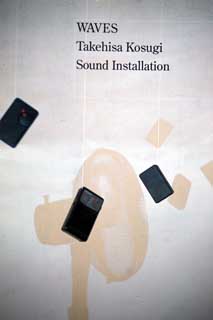 |
25. KOSUGI TAKEHISA: “Waves – Takehisa Kosugi Sound Installation” (Museum of Modern Art, Kamakura). (Excellent Condition). Catalogue distributed and only available for visitors at the exhibition of the Museum of Modern Art in Kamakura. This copy came from Kosugi himself. A4 size, 33 pages thick filled with notes and photographs. Price: 100 Euro |
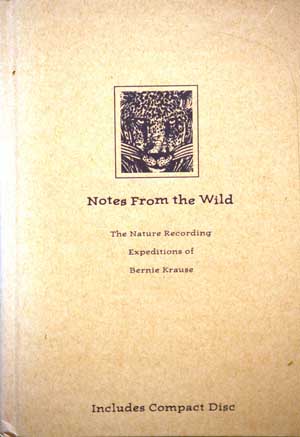 |
26. KRAUSE BERNIE: “Notes From The Wild – The Nature Recording Expeditions of Bernie Krause” (Ellipsis arts) (Book & CD in Mint condition). Hardcover, 94 paged and includes CD. “Bernie Krause records nature. Real nature, not those "ambient" or "relaxation" recordings for yuppies – sappy albums of crackling fires or waves at the beach. How many people will find the low, throaty growl of a jaguar relaxing? Krause hauls his portable tape deck out into what few remaining wildlands they are, sets up camp, and records nature as it happens. The results are unique; Krause has spent the past three decades studying his craft and learning how to set up his microphones and volume controls to capture nature exactly as it sounds in the wild. For this compilation, he has included samples from a South American jungle (with that jaguar nearby); the New Mexican desert (coyotes howling); Glacier Bay, Alaska; and the Rwandan jungle (gorillas growling).The accompanying book (or maybe the CD accompanies the book; it's hard to tell) includes entries from Krause's field diary during the trips to make these recordings. He also shares some autobiographical information, his philosophy of man's relationship to nature, and technical notes to give the listener background to these recordings.” (Jim Trageser). Price: 40 Euro |
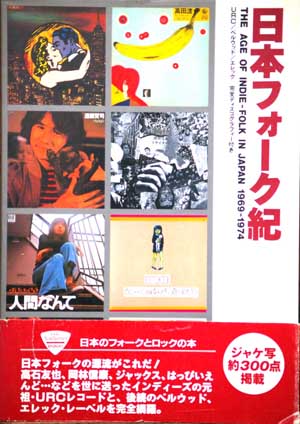 |
27. KUROSAWA SUSUMU: “Ni Hon Folk Ki – The Age of Indie-Folk In Japan 1969~1974” (Shinko Music) (Book & Dust Jacket: Near Mint/ Obi: VG++). 1992 1st edition. 226 pages. Only ever published complete research manual documenting Japanese underground folk and its labels through the years 1969~1974. Comes with tons of album jacket reproductions, release date info, vintage archive photos, history and catalogue label numbers. Price: 75 Euro |
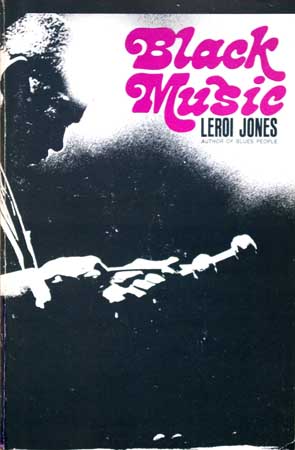 |
28. LEROI JONES: "BLACK MUSIC" (Quill) (Soft Cover & book are in excellent condition). Rare 1967 first original printing. 220 pages. Baraka wrote with ecstasy—highly informed and intricate—about ecstatically complex music. He also revealed literary and philosophical substance in it that gave form to my inchoate experience. I learned a lot about musical form and its affect from Baraka, as when he wrote, of John Coltrane, “Not only does one seem to hear each note and sub-tone of a chord being played, but also each one of those notes shattered into half and quarter tones,” and, also, “It is like a painter who instead of painting a simple white, paints all the elemental pigments that the white contains, at the same time as the white itself.” Baraka could discuss Coltrane’s most famous recording with sophisticated love and then add, “The frighteningly limited scale of ‘My Favorite Things’ is Ancient Musik to Coleman and Taylor.” He wrote with a wide-ranging erudition, tracing influences within the history of jazz and comparing them with the lineages of other art forms. And he tossed off phrases that distilled music into lyrical language, as when he said, of the alto saxophonist John Tchicai, that “his phrasing at times reminds one of Mondrian’s geometrical decisions,” and described his playing as a “metal poem.” In the essay “Jazz and the White Critic” LeRoi Jones observes: “Most jazz critics have been white Americans, but most important jazz musicians have not been.” In Black Music, his perceptive and provocative collection of articles, reviews, profiles, interviews, liner notes, and new essays, Jones has offered a remedy of sorts. In brilliant discussions of Billie Holiday, Thelonious Monk, Coleman Hawkins, Lester Young, Charlie Parker, John Coltrane, Ornette Coleman, Sonny Rollins, Cecil Taylor, Archie Shepp, Don Cherry, and Sun-Ra, he examines each musician’s personality, background, musical ambitions, accomplishments, and disappointments, to illuminate both the context and spirit of jazz. Price: 200 Euro |
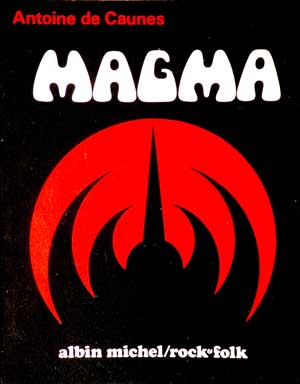 |
29. MAGMA – by Antoine de Caunes: “S/T” (Rock & Folk) original 1st press issue from 1978. 190 pages, fully illustrated history and in debt expose on Magma and Christian Vander up until that point. Stuffed with archival pictures and inside information. Rare Magma related book, completely vanished these days. This copy is in EX to Near Mint condition. Price: 150 Euro |
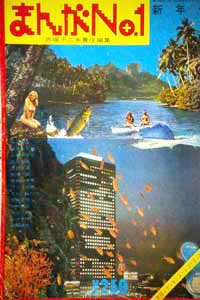 |
30. MANGA NO. 1 with Vol.3 with KAMISORI Q-KO & OONO YASUSHI & TSUNODA HIRO: “Sukeban Rock” (Ni Hon Sha) (215 pages comic book & assorted weirdness: Excellent/ Illustrated Flexi-disc: Mint ~ Unplayed). Wow, original January 1973 underground cum manga and music release, complete with Unplayed and still attached flexi disc present!! So what is/ was Manga No. 1? Well Manga No. 1 was some of the weirdest underground comic book magazines to come out in 1972. In total only 10 volumes made it unto the streets and each volume contained - next to totally deranged manga drawings of violence, sick caricatures, nudity, collage art and other misfit art forms – a flexi picture disc single that beheld into its grooves some outsider musical excursions by the likes of Mikami Kan, Yamashita Yosuke Trio, Sato Masahiko Trio and other assorted free form stylings. Of the 10 issues to be printed, only 6 of them came with a flexi disc. And this is one of them, a demented rap of counter cultural weirdness and erotic tinted nonsense that soon catapults off into a disenfranchised psyched out rock anthem parodying those early seventies pink violence erotic moves. Tsunoda Hiro of Flied Egg/ Jacks fame penned the music down and made it sound like a sake-drenched lunatic ride though a cum-stained wonderland avenue of sleaze, teenage angst, pubic hair and cheap whores. The Flexi comes adorned with sick high school fashion-styled transvestites on a rampage, there were no one else but Tadanori Yooko decorated the outside cover of the magazine!! A hallucinatory side effect when gazing at these pieces of art while listening to this slab of shemale avant-la-lettre art-psych-cum rock. Then there is the 215 pages thick manga that depicts sleaze art, demented comics, fresh oriental nudity and assorted weirdness that defies any categorization. Deliriously great. So if you are a Showa Japan era addict, or a sub-cultural manga fan or a lover of underground sounds, then this piece of art has written you all over it. A great piece of Japanese underground culture that will please all senses. Mega recommended and one of the key releases underground art and music sleaze releases ever. Original 1973 limited press in top condition. Packaging, material and contents are mind-blowingly great and will leave you gasping for air!!! Price: 100 Euro |
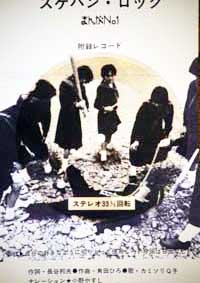 |
|
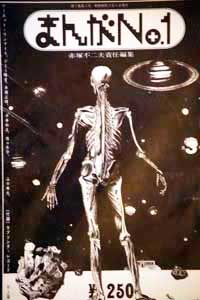 |
31. MANGA No. 1 with Vol.5 with INOUE YOUSUI & OONO SUSUMU: “Sakura Sangatsu Sanpomichi” (Ni Hon Sha) (215 pages comic book: Excellent/ Illustrated Flexi-disc: Mint ~ Unplayed). Wow, original March 1973 underground cum manga and music release, complete with Unplayed and still attached flexi disc present!! So what is/ was Manga No. 1? Well Manga No. 1 was some of the weirdest underground comic book magazines to come out in 1972~3. In total only 10 volumes made it unto the streets and each volume contained - next to totally deranged manga drawings of violence, sick caricatures, nudity, collage art and other misfit art forms – a flexi picture disc single that beheld into its grooves some outsider musical excursions by the likes of Mikami Kan, Yamashita Yosuke Trio, Sato Masahiko Trio and other assorted free form stylings. Of the 10 issues to be printed, only 6 of them came with a flexi disc. And this is one of them, executed and performed by city folk singer Inoue Yousui. Happy End styled vocalist Inoue Yousui bringing forth a piece of moody folk that differed greatly from the style of city-pop folk that reigned back in 1973. Inoue is more deep, a tad dark and melancholically laden, making it a compelling listening experience. Stunning song underscored with voices, flute and austere stripped down backing. A lost gemstone of a song. The Flexi comes adorned with Happy End/ Niagara inspired artwork by the hand of Harata Heikichi, there were no one else but Tadanori Yooko decorated the outside cover of the magazine!! A hallucinatory side effect when gazing at these pieces of art while listening to this moody downer piece of real people folk. Then there is the 215 pages thick manga that depicts sleaze art, demented comics, fresh oriental nudity and assorted weirdness that defies any categorization. Deliriously great. So if you are a Showa Japan era addict, or a sub-cultural manga fan or a lover of underground sounds, then this piece of art has written you all over it. A great piece of Japanese underground culture that will please all senses. Mega recommended and one of the key releases underground art and music sleaze releases ever. Original 1973 limited press in top condition. Packaging, material and contents are mind-blowingly great and will leave you gasping for air!!! Price: 100 Euro |
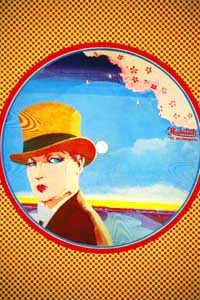 |
|
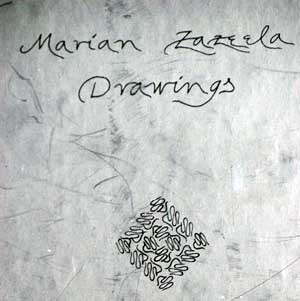 |
32. MARIAN ZAZEELA: “DRAWINGS” (Kunst in Regenbogenstadl Polling). (Book and Hard Cover are in Mint condition). Eye-popping designs by Lamonte Young’s partner Marian Zazeela. The catalogue was published by “Kunst im Regenbogenstadt” on the occasion of the show “Marian Zazeela Drawings”. Published in a small run in 2000. First and only edition. 142 pages, high quality paper and printing. Hard cover. Price: 150 Euro |
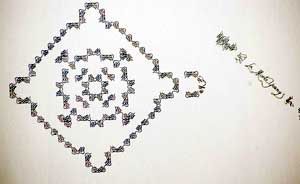 |
|
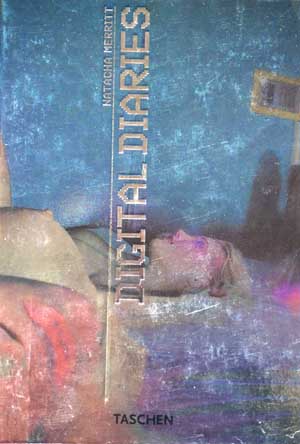 |
33. MERRITT NATACHA: “Digital Diaries” (Taschen 2000) (Hard Back cover and book are in Near Mint Condition). Photography – 256 pages, tightly bound hardcover. Natacha Merritt is doing just that. Through her digital images she shares with us all corners of her body, her fantasies, her lovers ... her world. She is delicate, beautiful and naive. She is sexy, tough and smart. Knowing what we know about Natacha gives us, the voyeurs, the feeling that we are welcome to explore her world, to piece together tales from the pictures we see. There is a great deal of tenderness in Natacha's work. Behind the images is a girl who wants to share herself with us. Digital Diaries is a new kind of book, defining a new kind of expression: digital, sexual, personal, private, public, raw, erotic, bold, self-conscious. Leave your prejudices at the door and step into the erotic world of Natacha Merritt. Merritt, born 1977, works with a digital camera, the Polaroid of the 90s, breaking down the most intimate details into universally accessible bits of information. Eric Kroll came across Natacha Merritt by chance in the Internet, where she had put several of her photographs. This was something that left the tradition of classical pin-up and fetish photography, in which Kroll himself works, far behind. Face to face with Merritt's photographs one can reflect on intimacy and publicity in the digital age, on narcissism even, or on radical self-exploration with the help of the camera. But this all sounds better as Natacha Merritt herself puts it: in her view, she has found a new mode of masturbating her way into the next millennium. Price: 50 Euro |
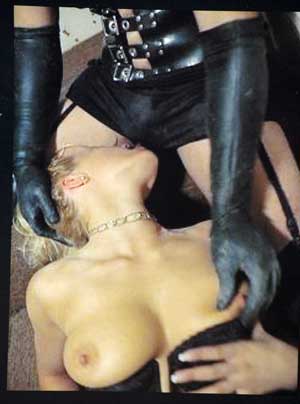 |
|
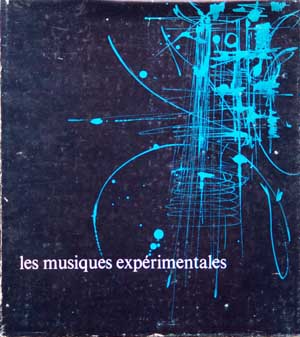 |
34. MOLES, ABRAHAM A.: “Les Musiques Experimentales” (Cercle D’Art Contemporain) (Hard Bound Book: Near Mint/ Dust Jacket: Excellent). Original 1960 First edition. 22 – 25 cm. 166 pages. Illustrated with archival pictures, diagrams and scores. In-depth study on Electronic Music and its practitioners, doctrines, techniques, history, structures and so forth. 1960 first printing, hardly turns up. Price: 75 Euro |
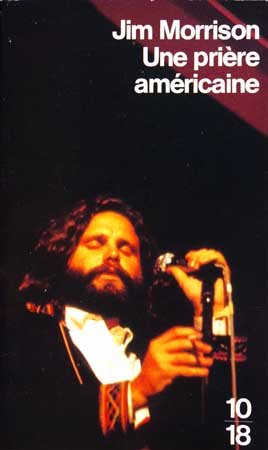 |
35. MORRISON, JIM: “Une
Priere Americaine – An American Prayer” (U.G.E Paris) (Excellent ~ Near
Mint) Original Bilingual French – English edition, published in France in
1978/ 85. 230 pages. Paperback issue. This was the first European edition of
Morrison’s poetry to hit the streets following Morrison’s demise in 1971.
Price: 50 Euro |
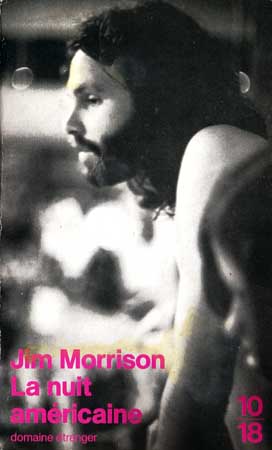 |
36. MORRISON, JIM: “La
Nuit Americaine” (U.G.E. Paris) (Excellent ~ Near Mint) Original Bilingual
French – English edition, published in France in 1992/ 94. 240 pages.
Paperback issue. This was the first European edition of Morrison’s poetry to
hit the streets following Morrison’s demise in 1971. Price: 50 Euro |
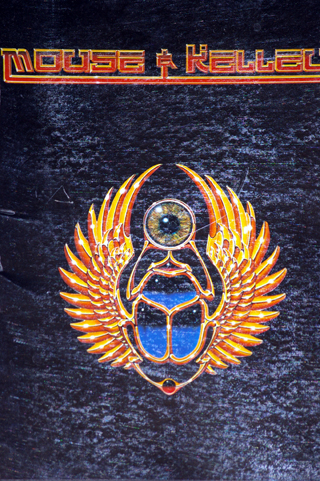 |
37. MOUSE & KELLY: “S/T” (Paper Tiger) (Near Mint Condition) original first edition of October 1979. 125 pages, high quality paper that sheds some insight on Frisco's finest poster and album jackets artists Mouse and Kelly. This book details their late sixties and early seventies creations with poster reproductions of all the great SF concerts, Human Beins, etc. I guess their art needs little to no introduction. This is a rare first edition book on their art and getting a tough one to dig up. Just beautiful and in top notch condition. Totally recommended. Price: 100 Euro |
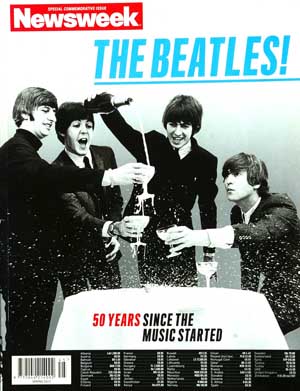 |
38. NEWSWEEK: “The BEATLES – Special Commemorative Issue” (Spring 2012) (Mint
Condition). Great special issue documenting on the Beatles 50th birthday, lavishly illustrated with tons of high quality pictures and exposes.
Price: 25 Euro |
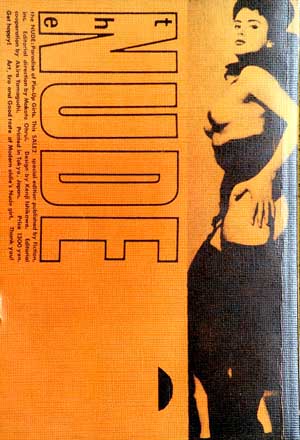 |
39. THE NUDE – Paradise of Pin-Up Girls by Makoto Ohrui. (Fiction Inc.). First printed edition of November 1984, only issued in Japan. As the cover stated “Art, Ero and Good Taste of Modern Oldie’s Nude Girl”. Brilliant, a 200 plus paged pictorial fully dedicated to 1950’s US Pin-Up girls and stripper, all presented in glorious and sleazed out black & white photographs. NM condition. Price: 100 Euro |
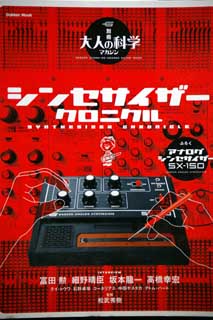 |
40. OTONA NO KAGAKU: “Synthesizer Chronicle” (Gakken Mook) (Book/ Jacket/ Self-to be-Built Synthesizer Kit: New and unopened). Lavishly illustrated on high quality glossy paper, giving a detailed account of the Synthesizer’s history, major players in the field, record guide and so much more. The magazine comes with a mini- Synthesizer kit, so you can build your own mini fully operational Synthesizer and you can even hook it up and connect it with the mini-theremin. It does play and you can jack it in into your speakers even. This is a limited edition issue that only the Japanese manage to fabricate. Due to the attached kit, this is quite a voluminous package and is almost 6 Cm thick. Long sold out, this is for electronic music buffs. Comes with tons of interviews with all the major players in the instruments history, electronic music field guide, even up until the glitchy 1980s YMO synth-pop days. Price: 50 Euro |
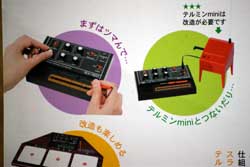 |
|
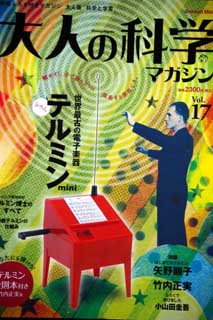 |
41. OTONA NO KAGAKU: “Theremin Mini” (Gakken Mook) (Book/ Jacket/ Self-to be-Built Mini-Theremin Kit: New and unopened). Lavishly illustrated on high quality glossy paper, giving a detailed account of the Theremin’s history, major players in the field, record guide and so much more. The magazine comes with a mini-theremin kit, so you can build your own mini fully operational theremin. It does play and you can jack it in into your speakers even. This is a limited edition issue that only the Japanese manage to fabricate. Due to the attached kit, this is quite a voluminous package and is almost 6 Cm thick. Long sold out, this is for electronic music buffs. Massive Price: 50 Euro |
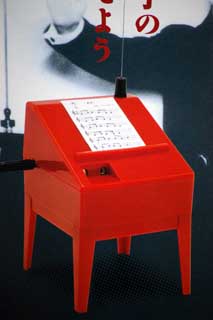 |
|
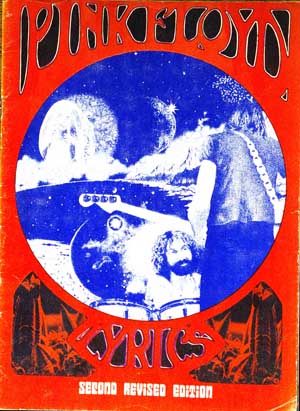 |
42. PINK FLOYD: “LYRICS” (Private Issue – 197?) (Excellent condition for cover and contents). Size is 20 cm – 275 cm. 28 fully illustrated pages. Book contains the lyrics to Pink Floyd albums ranging from “The Piper At The Gates Of Dawn” up till “Obscured By Clouds”/ “Zabriskie Point” and “Music From The Body”. In addition it also covers singles and bootlegs such as “Live In Rotterdam”, “Live In Hamburg”, “Big Pink”, “Omayyad” and “Tour ‘72”. So seen against this light, this publication must have seen the light around 1971~73. Fully illustrated by hand drawn psychedelic imagery. Never seen before Pink Floyd fanzine from back in the day. Price: 120 Euro |
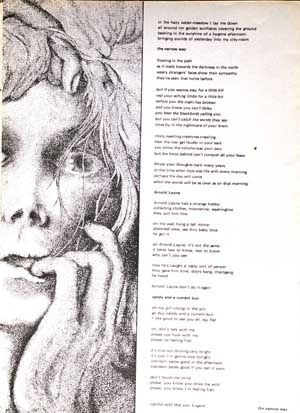 |
|
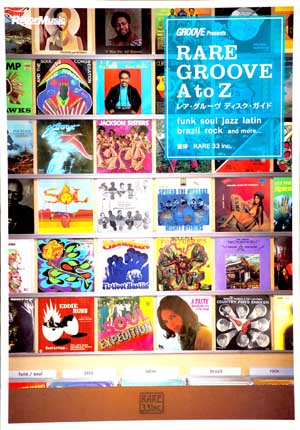 |
43. RARE GROOVE A to Z – Funk Soul Jazz Latin Brazil Rock and more…(Rare 33 Inc). Long out of print fully illustrated with color pictures guide to Rare Groove sounds. 288 paged filled with records, rarity scales and write-ups. Only came out in Japan in 2009. NM condition and with dust jacket present. Price: 85 Euro |
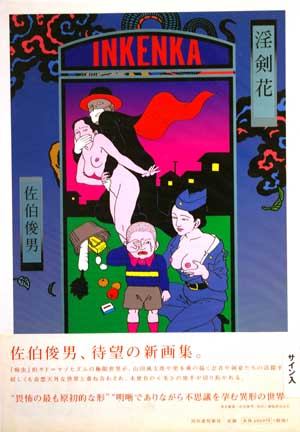 |
44. SAEKI TOSHIO: “Inkenka” (Kawada Shobo Shinsha)(Book & Obi & Dust jacket are MINT). Hideously rare and small print run that came out in 2001. This is a SIGNED copy by Saeki himself. A4 size, massively illustrated with Saeki’s beautifully grotesque and erotically loaded work. Thick high quality paper, thick sturdy jacket. Long out of print limited edition book. Toshio Saeki, Japan's master of erotic illustration devours the world with his demented images of outré sex. Saeki is mostly know as the illustrator of most of Mikami Kan’s early seventies LP jackets. “Think of Toshio Saeki's work as a gaping, red maw consuming all women (and some men), salivating over their bodies and licking them into a sexual frenzy before swallowing them whole, like giant pieces of sashimi. Japanese schoolgirls in uniforms, elderly matrons with wrinkled skin, attractive young women in kimonos and the occasional horny businessman or samurai -- all are sucked into Saeki's imaginary, Jabba the Hut-like pie hole, forced down his rapacious gullet and chased back with copious quantities of sake. Saeki, 55, is the godfather of Japanese erotica -- the one illustrator in the frenetic, oversexed, comics-crazy nation whose imagination outpaces all others. For decades, the art cognoscenti of Japan and elsewhere have hailed him as a psychosexual dream weaver who traverses all taboos with oozing, bloody scenes of insatiable carnality. Now he's being rediscovered by young adults in America and Europe for whom Japanese illustration, anime (animated cartoons) and manga (comic books) are perpetual sources of fascination. Just when you believe Saeki has shown you his most outré image, you turn the page and find additional macabre hallucinations of murder and lust. In one, a Japanese schoolgirl flies down a road on her bike, her haunches lifted in the air and her skirt flapping in the wind. She looks behind her in horror to see that her bicycle seat has morphed into a man's groaning face. In another, a young woman sips green tea as she rubs the freshly decapitated head of a soldier against her genitals, his body still upright beside her. There are drawings of necrophiliacs humping corpses and of crazed onanists sawing limbs off others with which to masturbate.” (Stephen Lemons). This nails Saeki’s works perfectly, so you can guess into what kind of waters you will steer yourself into upon purchasing this extremely limited edition book. Already out of print and long gone, do yourself and your morbid sex life a favor, dive into Saeki’s demented twisted world and feel normal again. This is fabulous stuff. Highest possible recommendation!! Beautiful. Haven seen a copy in ages. This one is top all the way. Price: 300 Euro. |
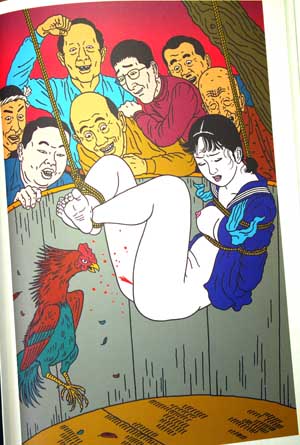 |
|
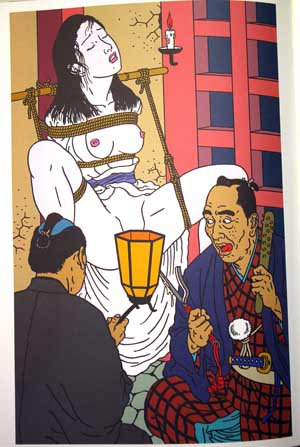 |
|
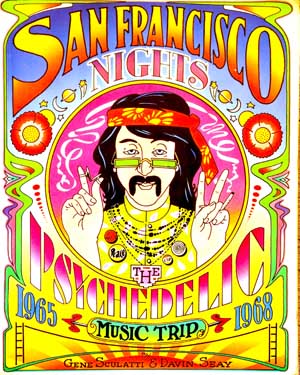 |
45. SAN FRANCISCO NIGHTS by Gene Sculatti & Davin Seay (Sidgwick & Jackson, UK 1985) First UK printing of this well-written exposé of the SF Bay Area '60s music scene and psychedelic music in general. Attractive design and plenty of high quality photographs. Similar to Barney Hoskyns' book with a strong focus on the music scene and plenty of nice images and design details, albeit on a less expensive scale. For those who are only interested in the music aspects of the scene it may be a good introduction, though the cover probably scares a lot of prospective buyers off. B/w photos and images throughout. 192 pp. Minor edge wear only. EX to NM copy. Totally vanished book. Price: 75 Euro |
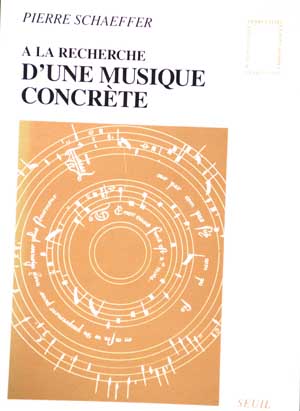 |
46. SCHAEFFER, PIERRE: “A La Recherche D’Une Musique Concrete” (Editions Du Seuil) (Near Mint Condition). Early 90s edition of Schaeffer’s 1952 masterpiece. 230 pages. Price: 30 Euro |
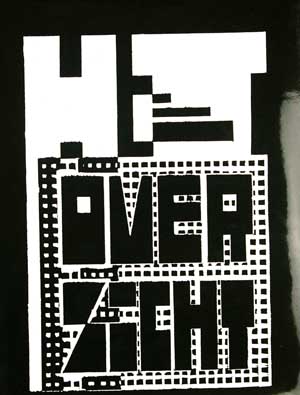 |
47. SEUPHOR, MICHEL: “Het Overzicht –
Collection Complete 1921〜1925” (Fonds Mercator Anvers) (Book – Dust Jacket:
MINT). Hideously rare first edition of 1976, complete with even the
always-missing little book attached on back flap of dust jacket. Born in Antwerp, Fernand Berckelaers adopted the
pseudonym 'Seuphor', an anagram for Orpheus, in 1917. During his long career as
a writer, poet, art critic and artist, Seuphor made an important contribution
to art history. From 1922 onwards Seuphor moved at the heart of the European
avant-garde in Berlin, Rome, Amsterdam and Paris and frequented the pioneers of
Cubism, Dada, Futurism, Constructivism and Neo-Plasticism including Robert and
Sonia Delaunay, Piet Mondrian, Fernand Léger, Albert Gleizes, Jean Arp
and Sophie Taeuber-Arp, Herwarth Walden, Filippo Tommaso Marinetti, Gino
Severini and Joaquin Torrès-Garcia.
In 1921 Seuphor founded the
Antwerp avant-garde magazine 'Het Overzicht', which he represented at important
conferences such as Theo van Doesburg's launch of De Stijl in Rotterdam
and the presentation of Casa Futurista in Berlin. In the German capital
he met the core of its forward-thinking intelligentsia and artists, including
Herwarth Walden, Moholy-Nagy, Walter Gropius and Filippo Tommaso Marinetti.
During 1924-25, 'Der Sturm' published Seuphor's poems. In 1925, Seuphor settled
in Paris where he befriended Piet Mondrian and collaborated with the futurist
Filippo Tommaso Marinetti. In 1929 he founded along with Joaquin Torres
García 'Cercle et Carré', a group dedicated to Abstraction.
Seuphor organized the group's exhibitions in which he brought together Mondrian,
Arp, Sophie Taueber, Léger, Schwitters, Kandinsky, Le Corbusier. As an
artist Seuphor found acclaim with a large exhibition organized by his friend
Jean Arp at the Galerie Berggruen in 1954. In 1977 the Gemeentemuseum in Den
Haag and the Centre Georges Pompidou hosted a major retrospective of his work.
Seuphor is credited with the invention of the so-called 'dessin à
lacunes', drawings and collages in which the abstract forms are created by the
empty spaces between the lines. Price: 300 Euro |
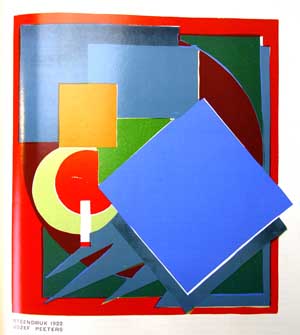 |
|
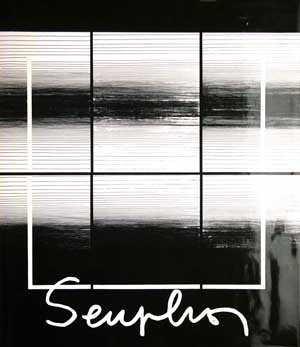 |
48. SEUPHOR, MICHEL: “Seuphor” (Fonds
Mercator Anvers) (Book – Dust jacket: MINT). Hideously rare first edition
of 1976, complete and in TOP condition. More than 300+ pages. very richly illustrated, bibliography works
Seuphor, list expositions Seuphor, general bibliography, index, colophon. Texts
in Dutch as in French, Original
publisher's white paper-covered boards, pictorial dust jacket, square 4to [viij], 364pp. Stunning and hopelessly obscure limited book
on this CoBrA artist. Price: 250 Euro |
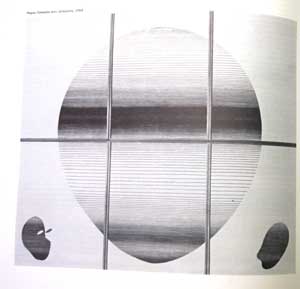 |
|
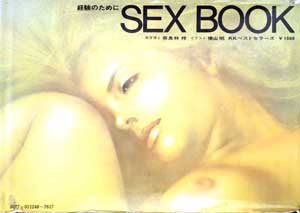 |
49. SEX BOOK: “Keiken No Tame Ni” (Hard Cover Book & Dust Jacket in Excellent Condition). 255 pages. rare mid 1970s Japanese erotic book guiding the reader through pictures and colorful shemes into the world of reproduction and erotic pleasures. The design is nothing short of colorful modern art. Beautiful sign of the swinging mid 1970s that colored Tokyo pink. Sleazy vintage 1974 book on a subject matter that leaves nothing to the imagination. Beautiful design. Price: 150 Euro |
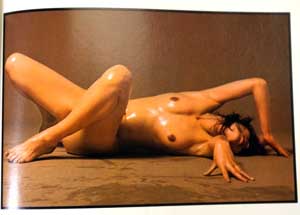 |
|
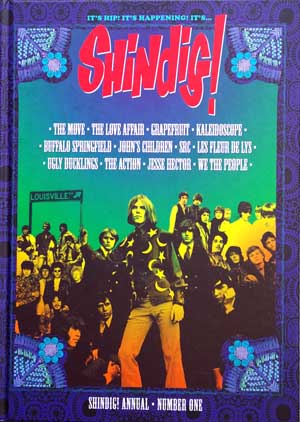 |
50. SHINDIG!: “Shindig! Annual - Number One” (Hard Cover Book & pages in MintCondition). 112 pages. Long out of print first annual volume of a collection of articles of Shindig magazine, this edition came out in 2008 and is long gone and out of print. Shindig! Annual No.1 serves up a tasty treat of vintage music treasures. It includes a mouth-watering collection of in-depth articles on an array of famous, infamous and influential artists from the 1960s and 1970s. All these articles are taken from early, now out-of-print issues of Shindig! Magazine - the bi-monthly hip and happening chronicle of new and vintage music - and re-designed with new photos and illustrations in this glossy112 page hardback book. The features: THE MOVE -- the last major interview with singer Carl Wayne, illustrated with unseen pictures from his personal archive. SRC -- the late '60s Detroit psych-rock act whose textured guitar/organ interplay and sci-fi inspired lyrics were unlike anything else from the region. JOHN'S CHILDREN -- singer Andy Ellison and drummer Chris Townson discuss their unruly school days, pre-John's Children mod bands, Marc Bolan's role in the group, touring Germany with The Who, manager Simon Napier-Bell and lots more. KALEIDOSCOPE -- singer Peter Daltrey's recollections of the changing trends in music and fashion prevalant in '60s London and the group's very own cutting edge psych. WE THE PEOPLE -- multifaceted '60s garage and psych from Florida. GRAPEFRUIT -- pretty boy Beatles' proteges rise and fall: great tunes, the Apple Empire and the end of the '60s. LES FLEUR DE LYS -- Gordon Haskell recalls his talented band, who despite bettering The Who on their version of 'Circles' and recording stellar psych-rock concoctions, never truly made it. THE UGLY DUCKLINGS -- Mick Jagger's #1 fave '60s Canadian rebel rousers. LOVE AFFAIR -- Steve Ellis on mod style, #1 hits and teenybop stardom. JESSE HECTOR -- the musical awakening of the original rockin' space-aged-mod-glam-punk. BUFFALO SPRINGFIELD/POCO -- Richie Furay interviewed. THE ACTION -- Reggie King on his top mod group, clothes, George Martin, record producing and escaping the industry. Shindig! Annual No.1 is an ideal Xmas present for friends or a well-earned treat for yourself! This collection of articles is an indispensible resource. Price. 40 Euro |
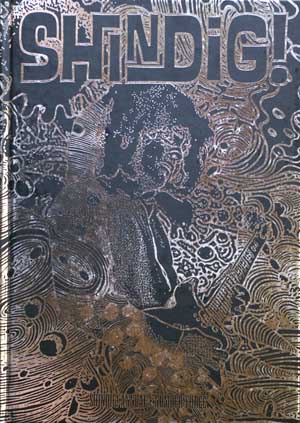 |
51. SHINDIG!: “Shindig! Annual - Number Three” (Hard Cover Book & pages in MintCondition). 100 pages. Long out of print third annual volume of a collection of articles of Shindig magazine, this edition came out in 2010 and is long gone and out of print. With a gorgeous silver-foil cover by Savage Pencil, Shindig! Annual #3 gathers the cream of Shindig! magazine's collectable out-of-print back issues and adds a couple of previously unpublished works exclusive to this publication. Featuring definitive articles many expanded and updated on the following artists: THE PRETTY THINGS The Brit-rock legends pioneering psychedelic adventures revisited. ----- THE FLAMIN GROOVIES San Francisco ballrooms, hard rock, glam, powerpop classics... they did it all. ----- THE 14 HOUR TECHNICOLOUR DREAM The British flower children s coming-out ball and how it changed British pop. ----- KEVIN AYERS Cult hero, counter-culture darling and quintessential English renaissance man. ----- ALICE COOPER Notorious shock-rocker s early garage years exposed. ----- THE SCAFFOLD The scouse avante-garde pop/comedy/poetry trio reappraised. ----- THE STRAWBS The early psychedelic days of the folk-pop stalwarts remembered. ----- FIRE Into the treacle toffee world of the UK mod/psych heroes. ----- PROCESSION The Aussi psych-pop gods who came to London in search of success. ----- In addition, we are proud to publish a pair of newly-minted features exclusive to this annual: GREEN BEAT The emergence of Irish rock and psychedelia in the mid-late 60s (David Daltrey) From teenage psych-pop with Tales Of Justine to jazz and beyond. Price: 40 Euro |
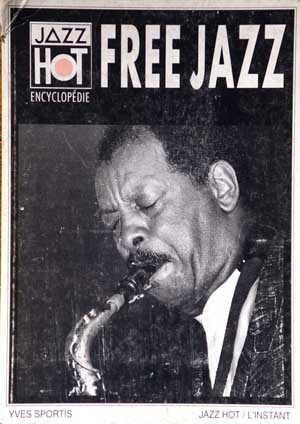 |
52. SPORTIS, YVES: “FREE JAZZ” (Jazz Hot/ L’Instant) (Book and cover are in Excellent condition, small tear near upper spine). Paperback, 121 fully illustrated pages, 15 cm ~ 22 cm. Rare and obscure 1990 book written in French on all aspects involving free jazz and its main exponents. Covers lots of ground and is vastly illustrated with album covers and tons of live actions shots of all; the main free jazz howlers live on stage somewhere in Europe. Hardly surfaces, 1st edition press. Price: 125 Euro |
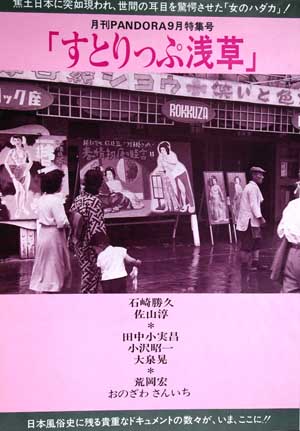 |
53. STRIP (Sutorippu) ASAKUSA: “Strip Asakusa” (Tomu Shobo/ Pandora) (Book and cover are in Near Mint condition, all pages firmly attached and no damages). Soft Cover, 110 fully illustrated pages, 30 cm ~ 21 cm. Very rare and obscure book that came out in 1982 and which documents in vivid and technicolor detail all the gory/ sleazy/ underbelly aspects of Tokyo's Asakusa district renowned Strip Clubs during the period of 1950 up until 1962. Filled to bursting with behind the scene pictures, shots of the punters and the ladies they came to admire, the gradual change from lurid strip show acts to full blown lesbian stage shows, snake handling naked nymphets, and other Japanese styled perversities that are a sight for sore eyes. A unique glimpse at Showa Era Tokyo's sleazy underbelly - which these days seems like a wormhole into a different dimension in time and space. This is an amazing and eye-popping document that is a must read/ browse through material for everybody from retarded priests up to militant feminists and other vicious dingbats who do not need sleep and are working overtime just to weed out and crush the last remaining remnants of the sexual revolution. Only second time ever I can lay my mittens on this glory-hole of a book and this one comes highly recommended. Bloody rare and obscure but such a beautiful revelation you will wish you were born 70 years earlier and could join the hedonistic fun. Price: 250 Euro |
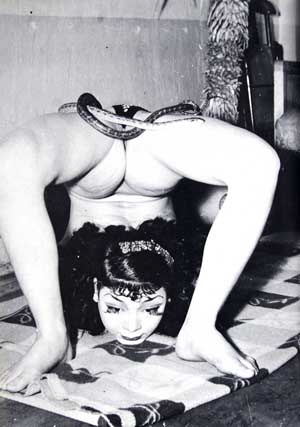 |
|
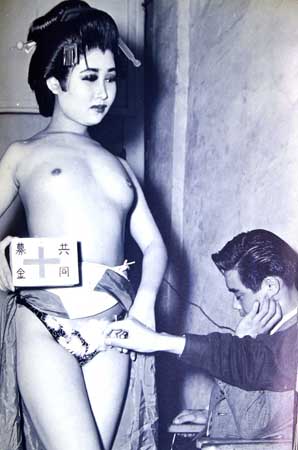 |
|
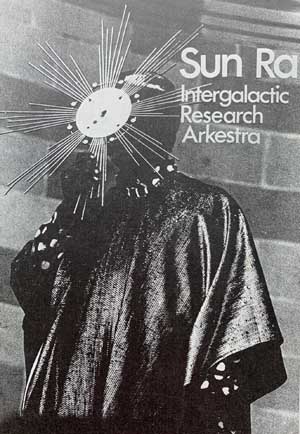 |
54. SUN RA: “Sun Ra Intergalactic Arkestra” (Souvenir Programme) (18 Paged Booklet: Mint) Bloody rare of a concert program booklet that was offered at Sun Ra’s 1st performance in Great Britain. It was held at the Queen Elizabeth Hall on Monday 9th November 1970. It comes with notes and pictures. The condition is like new, which is no small feat and is a unique piece of Ra’s tour in Europe at that time. Never saw one before until now and it is a bllody rare item but amazingly cool artifact. Comes printed on thick and high-quality paper. Stunning condition. Price: 300 Euro |
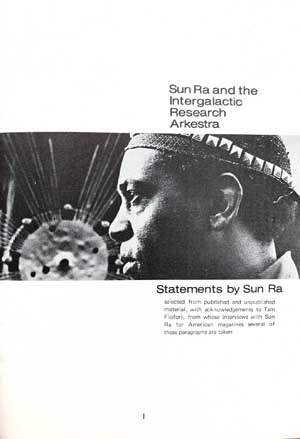 |
|
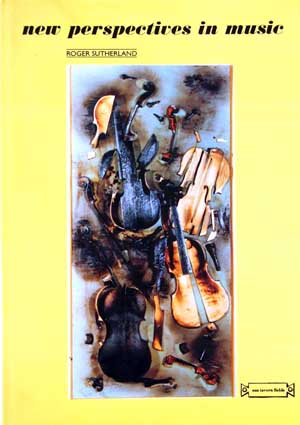 |
55. SUTHERLAND ROGER: “NEW
PERSPECTIVES IN MUSIC”. (Sun Tavern Fields) (Dust
Jacket: Mint/ Book: Mint). First printing of 1994 – 285 pages. This is a comprehensive survey of the musical
avant-garde, with highly informative chapters on Stockhausen, Nono, Xenakis,
Cage, Parmegiani, Electronic Music, Graphics, Live Electronics, Sound
Sculpture, Intermedia, Improvised Music, Taj Mahal Travellers, Serialism,
Gordon Mumma, La Monte Young, Fluxus, Toshi Ichiyanagi, Takehisa Kosugi, Ronald
Kyan, AMM, Scratch Orchestra, etc. Lavishly illustrated in large format (A4).
Written by former member of the Scratch Orchestra and founder of Morphogenesis.
Totally indispensable work on avant-garde music and electronic music. Long gone
and out of print. Pristine mint copy. Price: 100 Euro |
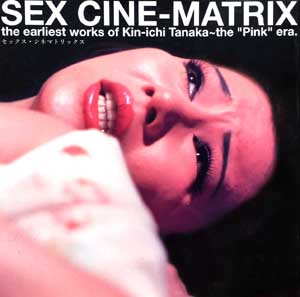 |
56. TANAKA KIN-ICHI: “Sex Cine-Matrix – The Earliest Works Of Kin-Ichi
Tanaka ‾ The Pink Era” (Oyozusho – 2007) (Dust Jacket: Near Mint/ Hard
Cover: Near Mint/ Pages: Mint). Long gone a totally vanished & out of print
amazing photo book documenting the Tanaka Kenichi, one of the famed directors
on the late 1960s and early 1970s Nikkatsu company’s porn flicks. Great color
photopgraphs collection of vintage Japanese erotic sleaze, early S&M shots,
grotesque love deliquencies, salacious high school love and much more demented
underground porn from those Golden Years balancing between the end of the 1960s
and the beginning of the 1970s. Hardly ever turns up, this is a top condition
copy. So needed and perfect companion to your Ike Reiko and Tani Naomi
listening pleasures. Price: 125 Euro |
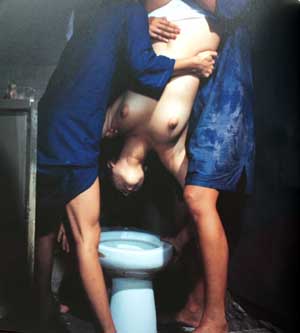 |
|
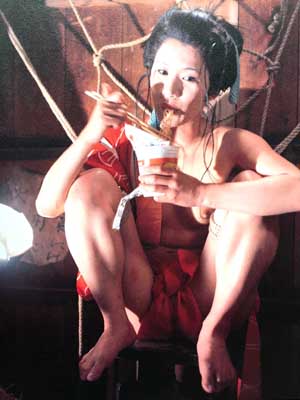 |
|
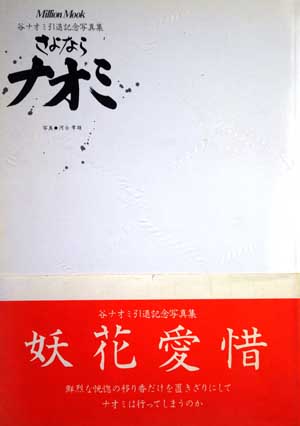 |
57. TANI NAOMI: “Sayonara Naomi – Tani Naomi
Intai Kinen Shashinshuu” (Million Mook – 1979). Freakingly rare 1st edition issue from 1979. Killer photo book released to commemorate Tani Naomi’s
retirement from the world of hardcore SM movies and porn. This photo book is a
stunning aural Valhalla dedicated to Tani Naomi and picturing her in all
imaginable tied up & naked bound poses. Comes with textured rope themed
cover. Comes also with a fully illustrated Tani Naomi cinema-graphy Totally
vanished on these shores. NM condition. 1st press issue from 1979.
Price: 300 Euro |
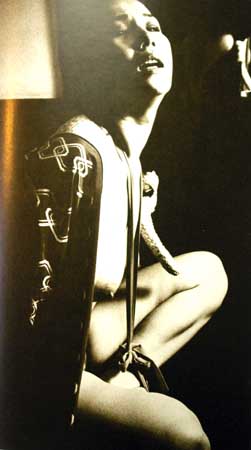 |
|
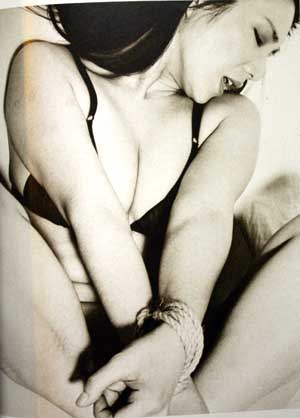 |
|
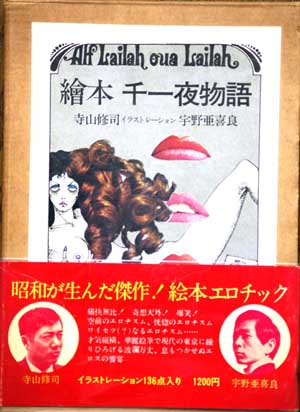 |
58. TERAYAMA SHUJI & UNO AQUIRAX: “ E-Hon - Sen Ichiya Monogatari” Shuji Terayama was a child of postwar devastation, occupation and subsequent economic expansion markedly different to Japan after the ‘economic bubble’. Terayama’s works range in media from radio drama, experimental television, underground (Angura) theatre and countercultural critique to Japanese New Wave and expanded cinema. His art and its radical embrace of the carnivalesque continue to entrance and provoke audiences internationally.Price: 300 Euro |
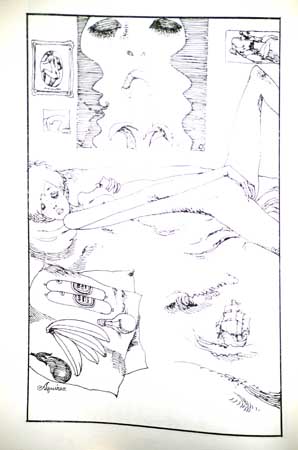 |
|
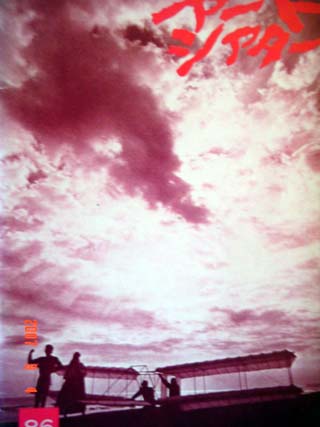 |
59. TERAYAMA SHUJI: “Art Theater – Sho O Suteyo, Machi E Deyou” (Book cover and pages are crispy mint). Date of issue: 1971, Issuer: ATG. Original 76 paged booklet (sized 24 CM ~ 15.5 Cm) filled with script, insights, loads of pictures and other demented sights and visions on Terayama Shuji's 1971 movie “Sho O Suteyo”. This booklet was distributed in a limited quantity and only available for the people who went to see the movie at the time of its release. Contains loads of pictures out of the movie, depicting the otherworldly deadpan vision of Terayama and a lot of a hell more. Very rare item I have only seen once so far. Original small number 1971 print, near mint condition and a must for all serious Terayama acolytes out there. Price: 100 Euro |
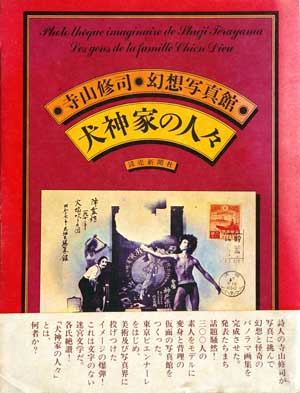 |
60. TERAYAMA
SHUJI: “Genso Shashin Kan - Inugamike no Hitobito ----
Phototeque Imaginaire de Shuji Terayama – Les Gens de la Famille Chien
Dieu” (Yomiura Shinbunsha – 1975) (Book and pages: Near Mint/ Dust
Jacket: Near Mint/ Obi: Excellent 〜 Near Mint). Hardcover book – thick
high quality pages – 150 pages. Rare first edition, first printing in
exquisite condition. Beautiful surrealistic photographic account on Terayama
Shuji’s visionary world of Tenjosajiki and beyond. Dali-esque at times,
definitely surrealistic in its approach, erotic and Showa era colored. A
beautiful glimpse at Terayama’s surreal world. Extremely rare first edition,
amazing condition and such a beauty to behold and browse through its pages.
This is art, no less. Highest recommendation. Price: 450 Euro |
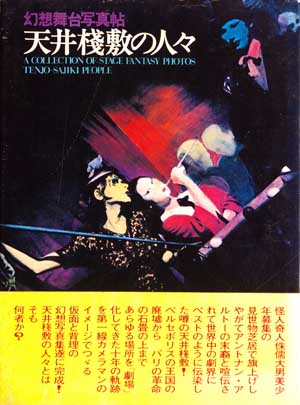 |
61. TERAYAMA
SHUJI: “Genso Butai Shashincho – Tenjosajiki No
Hitobito – A Collection of Stage Fantasy Photos Tenjosajiki People”
(Doyobishusha – 1977) (Hardcover Book: Near Mint/ Individual pages: Near
Mint/ Dust Jacket: Near Mint/ OBI: Near Mint). Bloody rare and obscure first
and only edition that came out in 1977 in a limited run. Comes complete with
always missing obi. 135 numbered pages, printed on tick high quality paper.
Such a great book but sadly enough hideously rare. Took me over a decade to
secure my own copy all complete with obi. This is without a doubt the closest
you can get to immerse yourself into the visionary and colorful world of
Terayama Shuji’s Tenjosajiki theatre world. Loads of eye-popping psychedelic
imagery, pictures of all the participants in action such as underground music
wunderkind J.A. Seazer. Dada-esque, surreal, erotic, psychedelic, provocative,
Dali-esque, confrontational, emotional and intoxicatingly bewildering.
Tenjosajiki was nothing short of a visionary spectacle that encompassed
everything and hit you full frontal. The most energetic psychedelic rock
theatre group ever to roam the face of the earth, this stuff is completely
addictive. Terayama ruled my world and even till this day he haunts my waking
hours. So essential, so utterly beautiful. Top condition first edition will OBI
present. Sadly enough….hopelessly rare and this one comes bloody cheap!!! Price:
500 Euro
|
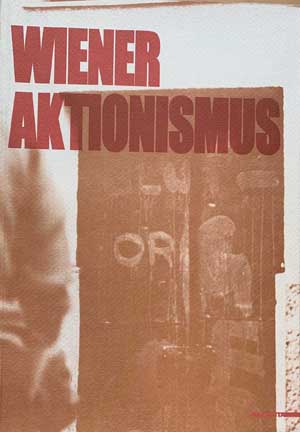 |
62. WIENER AKTIONISMUS: "S/T" (Edizioni Mazzotta - 2005) (Soft Cover Book is in Near Mint Condition). 270 pages, thick high quality printed paper and heavy. Amazing collection and fully illustrated work focussing on all the major participants of the Wiener Aktionismus scene, covering all the major participants from Hermann Nitsch to Otto Muehl, Gunter Brus, Arnulf Rainer, Franz West, Friedl Kubelka, Alfons Schilling, Adolf Frohner, Friederike Pezold, Erwin Wurm and a string of other actionists. Hardly ever offered before... and rare to say the least. One time only limited edition printing with a mass of pictures, reproductions, snapshots of the happenings and so much more delicious gore to feast your eyes on. Price: 150 Euro |
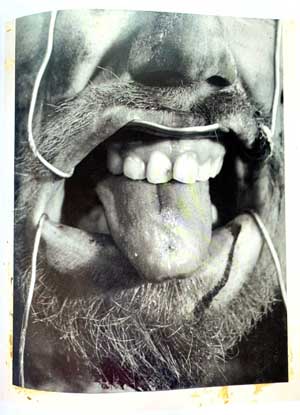 |
|
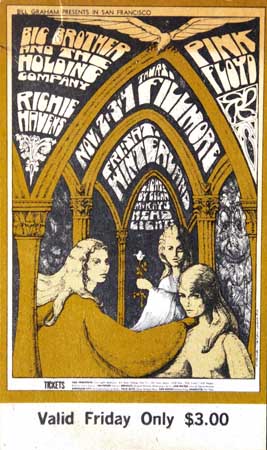 |
63. BILL GRAHAM Presents In San Francisco - Concert Ticket of NOVEMER 2nd, 1967 - featuring: "BIG BROTHER & The HOLDING COMPANY - PINK FLOYD - RICHIE HAVENS. Original Friday concert ticket - designed by Bonnie MacLean and features the same artwork as the poster that advertised this concert. Excellent ~ Near Mint condition. Beautifully preserved original concert ticket. Size is 6,5 cm to 11 cm. First original printing!!!! Price: 75 Euro |
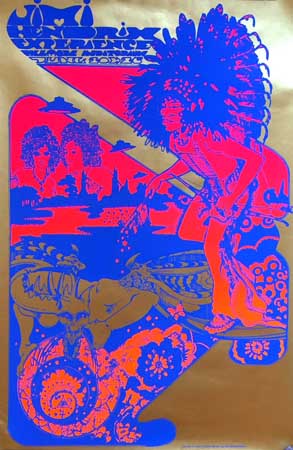 |
64. HENDRIX, JIMI: Original 2nd printing (came out exactly one year after the first print) 19&5/8" x 29&1/2" (50cm – 75 cm) silkscreen commemorative* concert poster for the Jimi Hendrix Experience appearing at the Fillmore Auditorium in San Francisco, CA from 6/20-26/1967. Design by Hapshash & the Coloured Coat (Michael English and Nigel Waymouth), image is OA 103 in the Osiris Visions (TRS) series. Medium flat stock silkscreen poster is in excellent to near mint condition; with no pin holes, has small wrinkle on bottom left side, apart from that pristine! This poster (*allegedly commissioned by Hendrix' management to commemorate Jimi's Fillmore debut) Original poster for June 20-26, 1968 Jimi Hendrix Experience concerts at the Fillmore Auditorium in San Francisco, CA. Printed in England by The Osiris Agency, this is one of the famous Hapshash series of posters from the late 1960s by artists Michael English and Nigel Waymouth. Hendrix seemingly commissioned this poster himself, and it is not an official Fillmore poster. It is however an official Hapshash poster, and rare in the fact that it is the only poster they did for an American concert. Metallic gold design incorporating day-glo pink and orange showing Hendrix as a Native American warrior w/bow and arrows in one hand, a peace pipe in the other. Additionally, poster features a dragon, UFOs and astrological, floral and butterfly designs. In the bkg. at upper left are the images of two men, the artists English and Waymouth. Great design.GORGEOUS colors on this one! Price: 475 Euro |
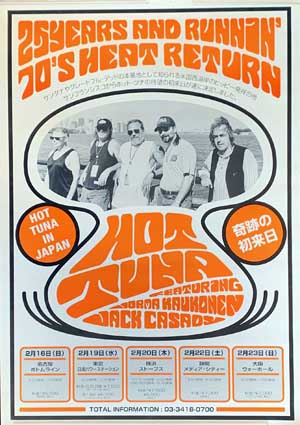 |
65. HOT TUNA: Live In Japan Concert Tour Poster from 1997. Size is 73 cm ~ 51 cm and is in top condition. Very few of these were originally printed and only graced the walls of some live venues back at the time. Beautifully stored since 1997 of scarce Japan tour. Price: 250 Euro |
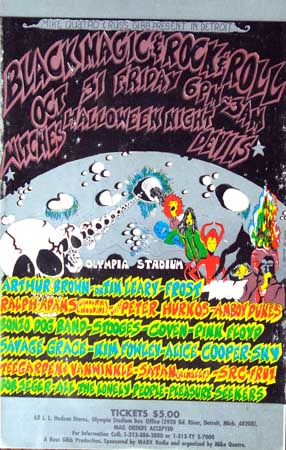 |
66. MIKE QUATRO & RUSS GIBB Presents In Detroit BLACK MAGIC ROCK & ROLL featuring: PINK FLOYD - The STOOGES - ARTHUR BROWN - TIMOTHY LEARY - AMBOY DUKES - KIM FOWLEY - ALICE COOPER - SRC - etc: Original 1969 doubled sided handbill. Here's an original/first print handbill from the historic Olympia Stadium in Detroit (home to the Detroit Red Wings during the Gordie Howe era). It was used to promote a single show co-promoted by Mike Quattro & Russ Gibb. Billed as "Black Magic Rock & Roll", this show took place Halloween Night 1969, and featured Pink Floyd, Dr. Timothy Leary, Stooges (Iggy Pop), Amboy Dukes (Ted Nugent), Bob Seger & Alice Cooper (a must for the Halloween theme). Very spooky psychedelic artwork comes courtesy of Linz, and the measurements are 11 cm - 17 cm. Top condition with no defects. Comes with heavy duty standing display frame. Price: 300 Euro |
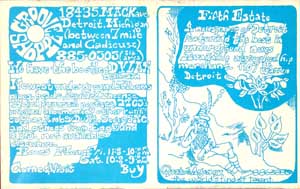 |
|
 |
67. AKIRA (AQUIRAX) UNO/ TERAYAMA SHUJI/ TENJOSAJIKI: “Hatsukoi Jigokuhen” (Excellent, minor repaired damage near top). ORIGINAL 1968 movie poster in excellent condition. Top has some minor damage that has been repaired. Impossible to score in whatever kind of condition since this movie was screened in only a few theatres at the time. This copy here is an original poster as used for the movie at a theater at the time. Beautifully designed by psychedelic UNO Aquirax, famed for his Tenjosajiki silk screens and other lysergic contributions. Rare does not even come close to describe the scarcity of this item. Dead cheap due to the minor damage on top. If it wasn’t for that the price would be a multifold. Price: 200 Euro |
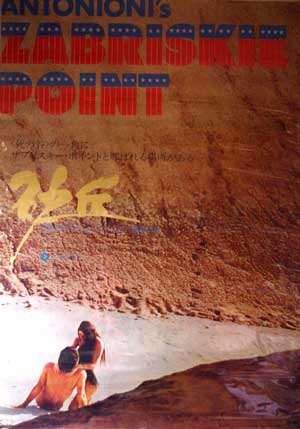 |
68. ANTONIONI’S ZABRISKIE POINT – Japanese original 1971 Movie Poster. (Mint Condition). Original 1972 Poster in mint condition with no pinholes, folding creases or tears. Size: 51 Cm – 72 Cm. Mint condition. Top notch copy - Japan only design similar to the Japanese only LP jacket design that came out for this movie. Price: 150 Euro |
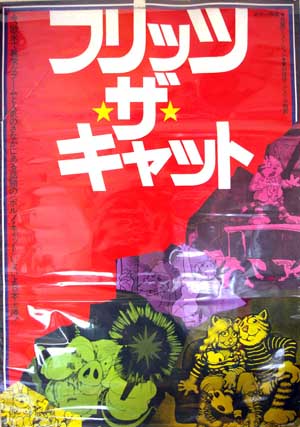 |
69. FRITZ THE CAT – Japanese original First edition Movie Poster (Excellent Condition). Original Japan only Poster in Excellent condition with no pinholes, folding creases- has small repaired tear.. Size: 51 Cm – 72 Cm. This is the FIRST issue poster - has a completely different design as 2nd and 3rd issue posters. First issue design just never surfaces, 1st time ever I encounter a copy of this masterpiece. Price: 175 Euro |
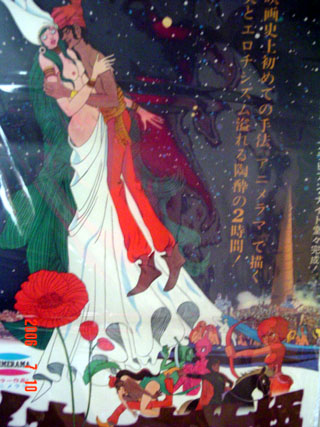 |
70. SENYA ICHIYA MONOGATARI: Also known under the title “Tales from a Thousand and One Night” from the Tetsuka studios/ Mushi Production. Original poster from 1969 in Near Mint condition, no tears, creasing folds or pin holes whatsoever. Some of you might notice this design as the same to grace the 2nd Helpful Soul album. This is the poster to the 1969 animated movie for which the Helpful Soul provided the soundtrack. Of course this 1969 original artifact is hideously rare. Original 1969 big sized poster. Design is gorgeous and is impossible to get these days. Stunning. Size: 53 Cm – 72 Cm. Mint condition. Price: 250 Euro |
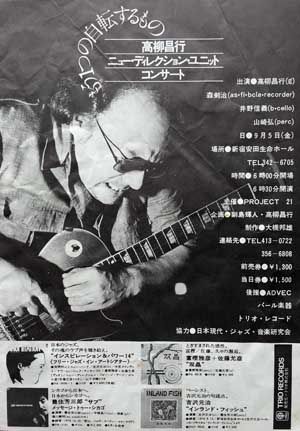 |
71. TAKAYANAGI
MASAYUKI Concert Pamphlet. 4 paged pamphlet is in Excellent condition but has some visible wrinkles all over. Size
is 18 cm – 25 cm. This must be from around 1975. Takayanagi flyers are
impossible to find as you know, never seen this one before. This picture was
also used on the cd release of “April Is The Cruellest Month”. Price: 200 Euro |
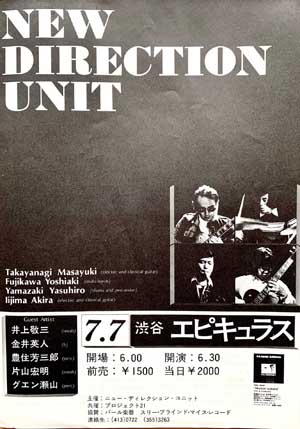 |
72. TAKAYANAGI MASAYUKI Concert Pamphlet. 4 paged pamphlet is in Excellent condition without any signs of much handling at all. Great condition. Size is 18 cm – 25 cm. This must be from around 1975 of a New Direction Unit concert heald at Shibuya’s “Epicuras” live house. The groups was comprised out of Takayanagi Masayuki (electronic and classical guitar), Fujikawa Yoshiaki (multi reeds), yamazaki Yasuhiro (drums & percussion) and Iijima Akira (electric and classical guitar). Takayanagi flyers are impossible to find as you know, never seen this one before. 4 paged and great condition. Price: 200 Euro |
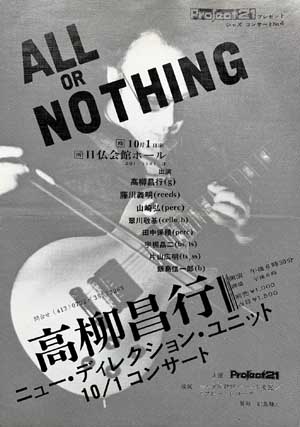 |
73. TAKAYANAGI MASAYUKI Concert Pamphlet. 4 paged pamphlet is in Excellent condition without any signs of much handling at all. Size is 18 cm – 25 cm. This must be from around 1975 of another New Directions Unit concert gig. Takayanagi flyers are impossible to find as you know, never seen this one before. This picture on the front is a cool image of Takayanagi with bow in hand handling the guitar. Great condition 4 paged flyer. Price: 200 Euro |
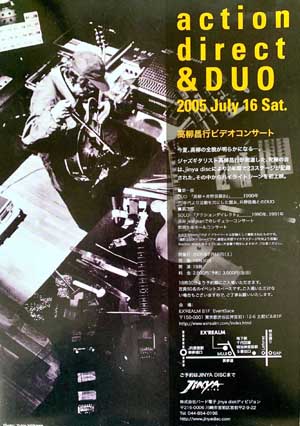 |
74. TAKAYANAGI MASAYUKI ACTION DIRECT & DUO. – Top shape – celebration video concert mini poster/ flyer of event held on July 16th, 2005. Price: 50 Euro |
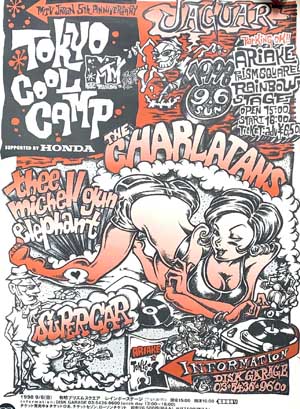 |
75. TOKYO COOL CAMP Concert Poster For MTV Japan 5th Anniversary concert - sized 52 cm ~ 73 cm. Near Mint condition with NO pinholes or sign of use. Legendary gig poster featuring as headliner the Brit Pop band the CHARLATANS alongside The Michel Gun Elephant and Supercar. This took place in 1998. Rarely surfaces in such nice and unused knick. Price: 175 Euro |
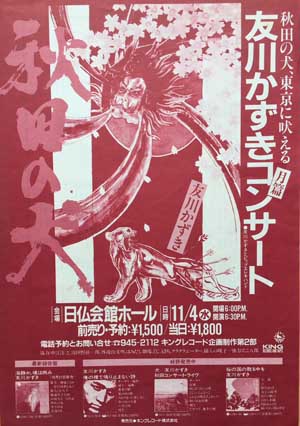 |
76. TOMOKAWA
KAZUKI Concert Mini Poster. Mint
condition – size is 21 cm – 30 cm. Dated also to around1978 or so.
Double sized printing. No pin holes. One of a kind. Price: 200 Euro |
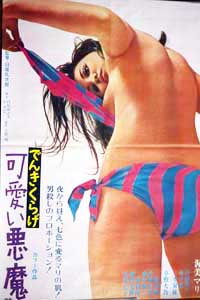 |
77. ATSUMI MARI: “Kawai Akuma” (Near Mint Condition). Original movie poster by this pink cutie goddess. Size is 51cm – 72 Cm with no pinholes of folding creases. Top condition. Year of release is 1970 and this poster is an original from then. Price: 150 Euro |
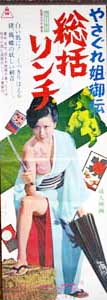 |
78. ISHII TEUO: “Soukatsu Rinchi” (Near Mint Condition) starring IKE REIKO – ORIGINAL poster. Rare early seventies original movie poster in excellent condition. This is one of the rarest Ike Reiko posters of that time, especially in this condition. Size: 26 cm – 73 cm. No pinholes and in stunning great condition. Original 1972 Speed type movie poster. Price: 200 Euro |
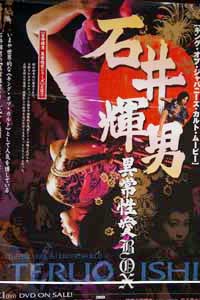 |
79. ISHII TERUO: “S/T” (Mint Condition) Extremely limited edition promotion only poster to accompany the release of the 5 DVD box set that came out 5 years ago. The poster was only handed to a select number of shops that stocked up on the box set so it was never offered for sale. Exquisite design of a tattooed roped woman. Pinky violence in Tokugawa era Japan, what more do you need?? Size: 51 cm – 72cm. In new condition. Price: 100 Euro |
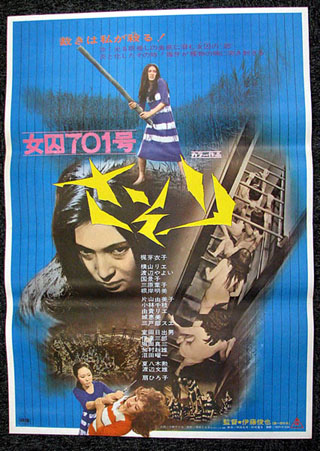 |
80. ITO SHUNYA - KAJI MEIKO – Joshu Sasori 701 Go: “Female Convict Scorpion #701” First in the Sasori series for Toei. Original 1972 Poster in mint condition with no pinholes, folding creases or tears. Size: 53 Cm – 72 Cm. Mint condition. Top notch copy. Vintage Kaji Meiko posters in top notch nick are a tough find these days. This one here is almost virginal in its state, top notch condition. Stunning. Price: 200 Euro |
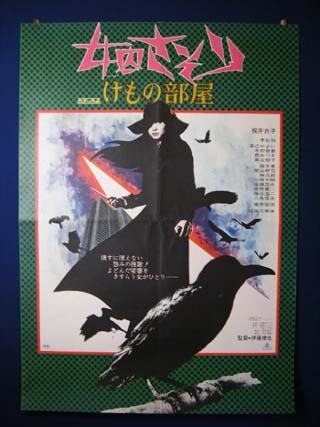 |
81. “KAJI MEIKO SASORI– Kemono no Heya”. Original 1973 Poster in excellent condition with no pinholes, folding creases or tears. Size: 53 Cm – 72 Cm. Mint condition. Top notch copy. Vintage Kaji Meiko posters in top notch nick are a tough find these days. This one here is almost virginal in its state, top notch condition. Stunning. Price: 150 Euro |
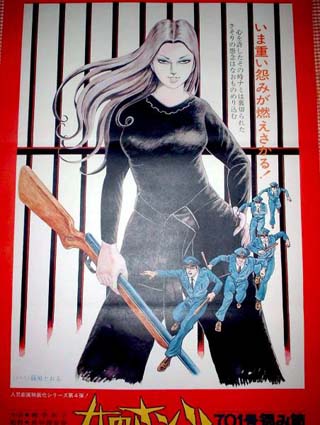 |
82. KAJI MEIKO Poster: Also known under the title “Female Convict Scorpion- 701 Grudge Song” Original 1973 big sized poster, tremendously rare. This one is adorned with the rarely seen manga character unto which the Sasori series was based and who was played by Kaji Meiko. Impossible to find these days and ultra collectible. Poster has no pinholes and is in exquisite condition, best copy I have ever laid my eyes upon. Apart from that in excellent condition. Please ask for more pictures if you want more visual details. Size: 53 Cm – 72 Cm Price: 175 Euro |
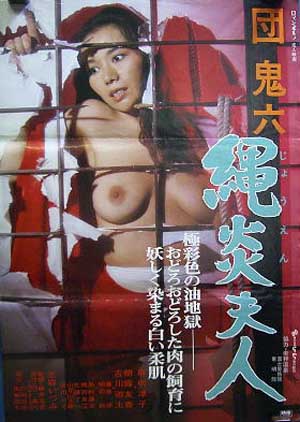 |
83. MABUKI JUNKO: “Jouen Fujin” (Excellent Condition). A true rarity, an original movie poster by hardcore S&M actress Mabuki Junko, who was only active for a short time before disappearing completely. Junko appeared on the scene of hardcore bondage and S&M flicks after Tani Naomi had thrown in the towel and because of that she would be the last of the big screen porn and S&M stars to emerge during Japan 's Golden Age of Roman Porno. She was especially great in S&M movies such as “Showa Erotica – Bara no Kifujin”, “Dan Oniroku – Hakui Nawa-Jigoku” and “Onna-biyôshi: Nawa-shiiku” and her on screen presence caused Dan Oniroku to dub her as “if Tani Naomi is the Marilyn Monroe of the SM scene, then Mabuki Junko is its Ingrid Bergman”. Tiliqua Records even went as far as releasing her obscure tape recording, a feat Junko solely recorded at the height of her short-lived career. The tape “Ai no Dorei”, turned out to be the most perverted and sexually deranged recording ever to be released. Anyway, this here is a rarely seen original movie poster by her. Size is 51cm – 72 Cm and the poster is in overall excellent condition, only folding crease from storage. Never surfaces… Price: 250 Euro |
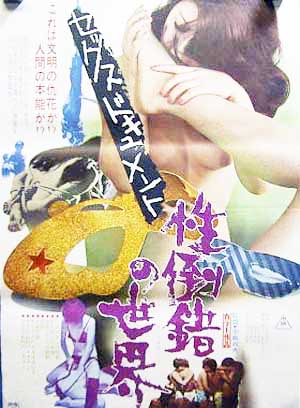 |
84. NAKAJIMA SADAO: "SEX DOCUMENT ~ SEITOSAKU NO SEKAI" (Excellent Condition). Original 1971 sleaze porn movie poster out of the Tokyo underbelly. Also known under its title "Sex Document ~ The World of Sexual Perversions", it leaves little to the imagination. Voyeuristic in its build up, the movie is a classic in its genre. The size is 51 cm ~ 72 Cm. There are pinholes in each corner and a folding crease due to year long storage. Original 1971 poster and one of the still undetected great sleaze ball underground flicks to scatter seamen stained theatres during that golden age. Rare does not even come close to describe this poster but due to its still undetected stature, dead cheap. Top condition. Price: 100 Euro |
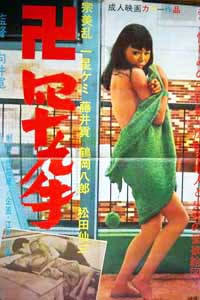 |
85. SHI JUU KYUU TE: “S/T” (Excellent, has folding crease from storage). Completely obscure and below the radar pink release from the early 1970s, think this was actually 1971 ̄2. Not much info floating around but worth checking out if there is s screening near you. Size: 51cm – 72 Cm, in overall excellent condition, with only a folding crease. First time ever I came across an original poster from this flick, the design is just stellar. Price: 100 Euro |
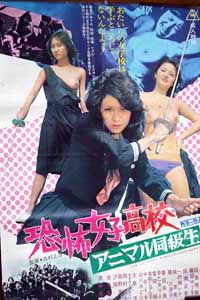 |
86. SHIMURA MASAHIRO: “Kyofu Joshikoko – Animaru Dokyusei” (Excellent Condition) Starring IKE REIKO. Also known under the title “Terrifying Girl's High School: Animal Classmates”. Original 1973 poster. The size is 51cm – 72 Cm excellent condition, has a few pinholes and only one folding crease caused by storage. Vintage original out of December 1973. High school girls on a rampage, a pink violence classic thrasher!!. Original poster. Price: 200 Euro |
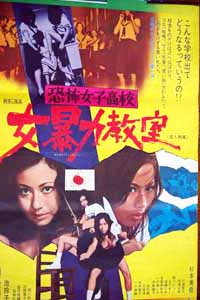 |
87. SUZUKI NORIFUMI - IKE REIKO & SUGIMOTO MIKI: Kyofujoshikoko – Onna Boryoku Kyoshitsu” (Excellent Condition). Size: 51cm – 72 Cm excellent condition, has some pinholes from use in movie theatre. Original September 1972 poster. Bad girl pink violence, bare nipples, frontal nudity and dynamite trash violence. High school girls on a rampage, your worst nightmare of secret desire. Vintage original poster, stunning piece blessed with that eye-popping trash aesthetic. Freakingly rare original in top condition. Price: 200 Euro |
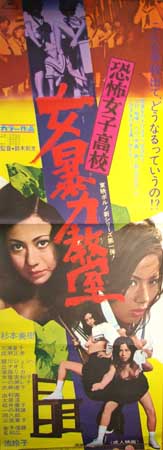 |
88. SUZUKI NORIFUMI with SUGIMOTO
MIKI: “Onna Boryoku Kyoshitsu” (Poster is MINT with no
pinholes) Tatekan style, size:
26 cm – 72 Cm near mint condition, there are NO pinholes, only a folding
crease caused by decades of safe storage. Different design as the above one. Original
vintage movie poster of this flick starring the tantalizing Sugimoto Miki as
the main actress, flanked by Ike Reiko. Also known under the title "Terrifying
Girl's High School: Lynchlaw Classroom”. Original Tatekan type poster, as it
was released together with the move when it hit movie theatres back in March
31st, 1973. Great pinky violence artifact in top-notch condition. Japanese
early seventies pink violence porn movie poster. TOP condition!!! Price: 100
Euro |
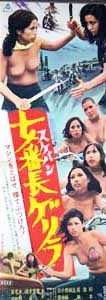 |
89. SUZUKI NORIFUMI: “Sukeban GERIRA” (Mint Condition). Starring SUGIMOTO MIKI and folk hero AGATA MORIO. Original August 1972 speed type movie poster. Size of the poster is 26 cm – 73 cm. Mint condition. Sex, trash and dynamite….a winning combination. Price: 200 Euro |
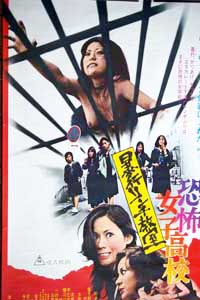 |
90. SUZUKI NORIFUMI starring SUGIMOTO MIKI & IKE REIKO: “Kyofu Joshi Koko Boko Rinchi Kyoshitsu” (Excellent Condition). Size: 51cm – 72 Cm excellent condition, only near the bottom seam a few little tears, apart from that near mint. Original vintage movie poster of this flick starring the tantalizing Sugimoto Miki as the main actress. Also known under the title “Terrifying Girl's High School: Lynchlaw Classroom”. Original 1973 Speed type poster. Great pinky violence artifact in top-notch condition. Japanese early seventies pink violence porn movie poster. Price: 200 Euro |
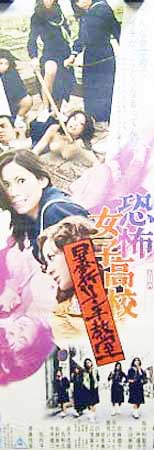 |
91. SUZUKI NORIFUMI starring SUGIMOTO MIKI & IKE REIKO: “Kyofu Joshi Koko Boko Rinchi Kyoshitsu” (Near Mint Condition). Tatekan style, size: 26 cm – 72 Cm near mint condition, there are NO pinholes, only a folding crease caused by decades of safe storage. Original vintage movie poster of this flick starring the tantalizing Sugimoto Miki as the main actress, flanked by Ike Reiko. Also known under the title"Terrifying Girl's High School: Lynchlaw Classroom”. Original Tatekan type poster, as it was released togehter with the move when it hit movie theatres back in March 31st, 1973. Great pinky violence artifact in top-notch condition. Japanese early seventies pink violence porn movie poster.TOP condition!!! Price: 150 Euro |
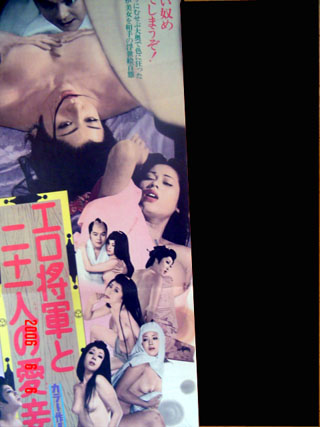 |
92. SUZUKI NORIFUMI: “Ero Shogun to 21 Nin no Aisho” Starring IKE IKE REIKO & SUGIMOTO MIKI. Also known as “Shogun General's 21 Dolls”. Original 1972 Speed type movie poster. Size of the poster is 26 cm – 73 cm. Near Mint condition. Price: 90 Euro |
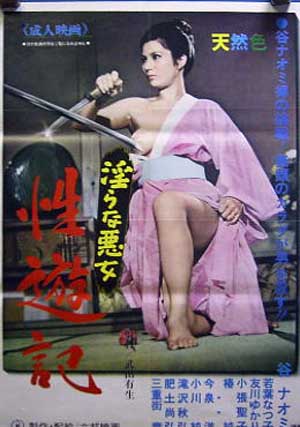 |
93. TANI NAOMI: “Nidarana Akujo – Seiyu-ki” (Excellent Condition, has folding crease). Original movie poster. Size: 51cm – 72cm. Excellent condition, only folding crease. No pinholes. Tani Naomi was Japan's finest bondage and S&M Queen who tore up cinema screens during the better part of the 1970s. She was also the first ever hardcore S&M actress to grace the white screen. Here she depicts one of the finest examples of Showa-induced feminine erotica, wielding a sword in an utterly depraved erotic way. The effect is stunning, an utterly fornlorn sense of the Showa erotic pregnant with the hard stuff she depicted on screen. But still, she brilliantly succeeds in conveying the atmosphere of true Japanese eroticism, a fleeting and fragile emotion that evaporated in the cynical miasma of the eighties. Original copy. Tani Naomi posters are very hard to track down, the theatres the films were first shown were sleazy back alley affairs, little or no promotion was done, hence the scarcity of these babies. Price: 150 euro |
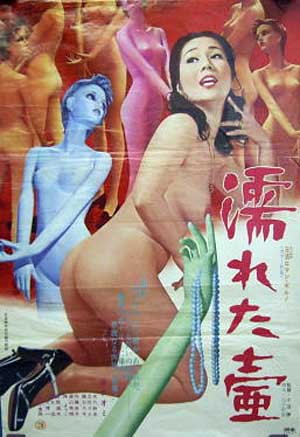 |
94. TANI NAOMI: “Nureta Tsubo” (VG++ ~ Excellent). Size: 51cm – 72 Cm excellent condition, only has a folding crease in middle, grading would be EX no pinholes. Another prime example of Tani Naomi’s glorious blitzkrieg towards the high peaks of first generation hardcore S&M flick and another classic. Original real time movie poster. Price: 75 Euro |
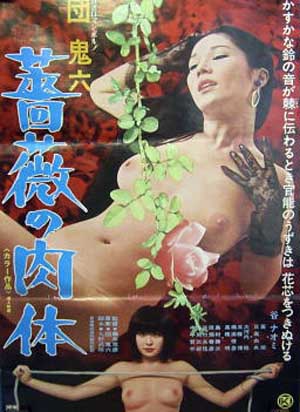 |
95. TANI NAOMI: “Dan Oniroku – Bara no Nikutai” (Excellent Condition, 2 folding creases) Size: 51cm – 72 Cm. Overall excellent condition, only 2 folding crease. Near edges some small creases from storage and folding crease in middle, grading would be EX no pinholes. Another Vintage Tani poster. Price: 120 Euro |
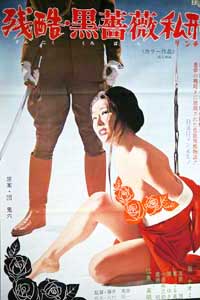 |
96. TANI NAOMI: “Zankoku Kuro Bara Rinchi” (Mint Condition). Size: 51cm – 72 Cm and in mint condition, hard to score items like this in such a nice condition. Tani Naomi’s S&M movie posters are amongst the toughest to track down. This copy is as good as they possibly come, a piece of Japanese sleaze eroticism out of an era that will never reappear. Historic to say the least. Price: 100 Euro |
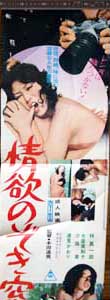 |
97. JOYOKU NO SOGI MADO: Original 197? Speed type movie poster. Size of the poster is 26 cm – 73 cm. Excellent condition, only has pinholes in corners and folding creases from storage. Beautiful copy of this totally obscure erotic movie. First time ever I see this poster, again 1970s vintage original, a small miracle that such items are preserved. Price: 125 Euro |
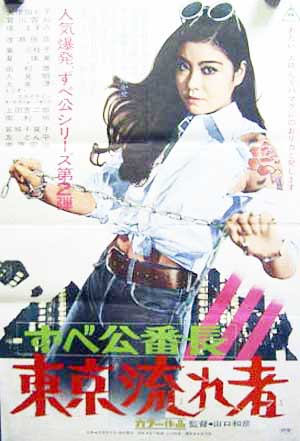 |
98. YAMAGUCHI KAZUKIKO: "ZUBE KOBANCHO ~ TOKYO NAGAREMONO" starring OSHIDA REIKO!!!! (Near Mint Condition). Original December 3th 1970 movie poster. The size is 51 cm ~ 72 cm. There are NO pinholes, only a folding crease caused by almost 40 years of storage. In short top condition and another essential entry in the sleazy world of pink violence. This one only surfaces very rarily. Top condition piece for next to nothing. Price: 125 Euro |
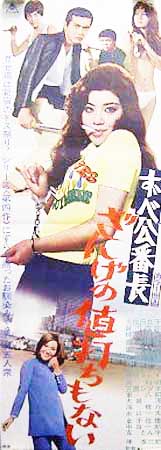 |
99. YAMAGUCHI KAZUKIKO: "ZUBE KOBANCHO ~ ZANGE NO NEUCHI MO NAI" starring OSHIDA REIKO!!!! (Near Mint Condition). Original Apryl 24th 1971 movie poster. Tatekab version, being long slim and the hardest to track down. The size is 26 cm ~ 72 cm. There are NO pinholes, only a folding crease caused by almost 40 years of storage. Another beauty in perfect condition that features the primal queen of pink violence flick, the always adorable Oshida Reiko. Jusr fabulous. Top condition. Price: 100 Euro |